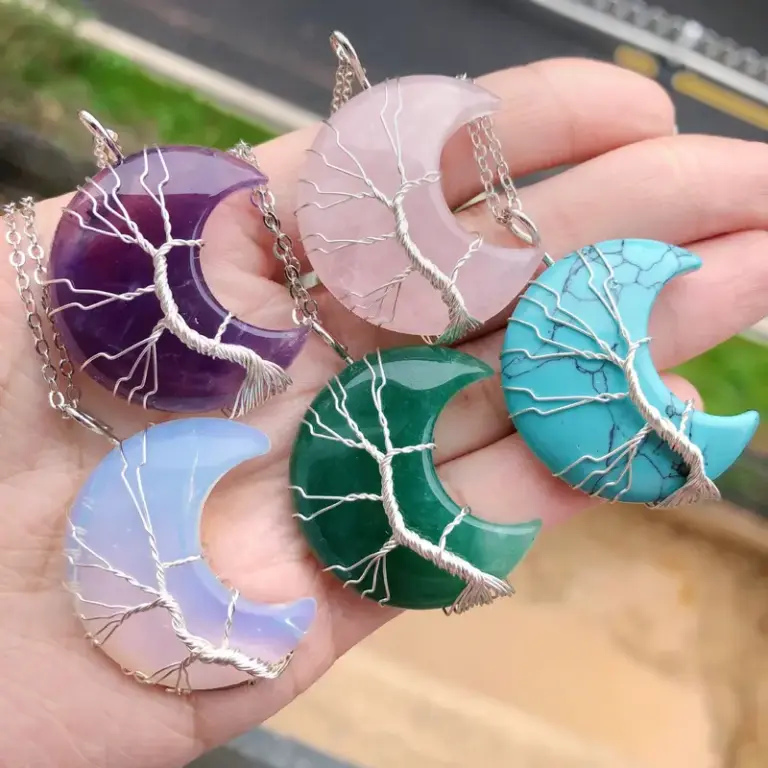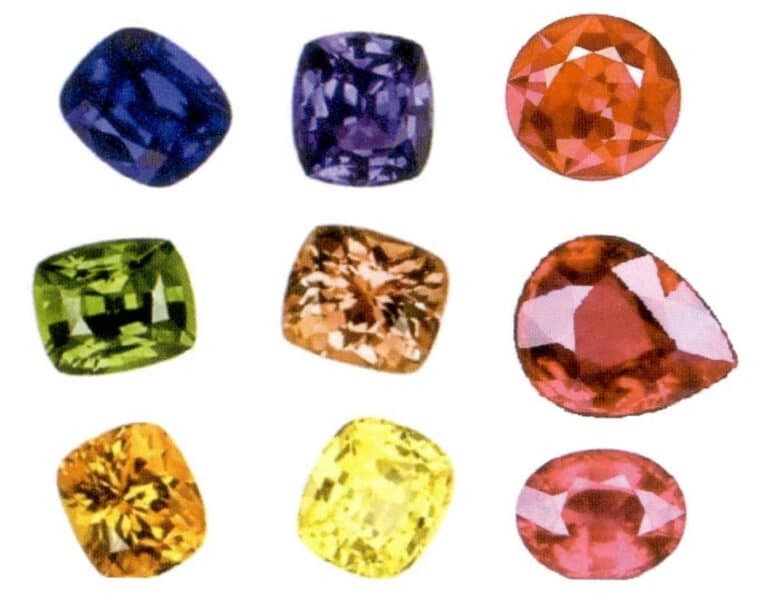What Are The Key Elements Of Jewelry Display Design?
Essential Guide (Overview, Principles and Connotation) to Jewelry Display Design
Pendahuluan:
This document provides a comprehensive guide to the essential elements of jewelry display design. It begins with an overview of display design, explaining its concept, significance, and historical development. The text then delves into the specifics of jewelry display design, highlighting its importance in the modern retail environment. It outlines the key principles that guide effective display design, such as form, ergonomics, lighting, and color. Additionally, the document explores the various components and techniques used in creating a captivating jewelry display, including display fixtures, lighting design, color application, and multimedia integration. Whether you are a jewelry store owner, designer, or brand manager, this guide offers valuable insights to enhance your display strategies and attract customers.

Commercial Space Design
Daftar Isi
Section I Overview of Display Design
1. The Concept of Display Design
Display, in English, is derived from the Latin words Displicare and Displico, meaning “to show” or “to be seen,” representing a state of exhibition. Modern display design refers to the recreation of space within a defined range of time and space, utilizing unique artistic creativity and technological means to create a distinctive spatial atmosphere that perfectly showcases the exhibits, allowing for ideal communication between the exhibits and the audience. This type of spatial design is known as display design.
Exhibition designers need to possess skills in marketing, planning, three-dimensional modeling, and crowd flow arrangement, as well as a certain level of knowledge in water and electricity and an understanding of the latest electronic technologies.
Exhibition design is a type of “performance-based” design. Before designing, the designer must first understand the “object or concept being exhibited,” identify the theme to be expressed, and then render and interpret the “theme” through the exhibition space and props to complete the design. Whether the exhibition space and props are spectacular is not the most important; the focus is on whether the exhibits stand out. Commercial space design and exhibition design are branches of this field.
The content of commercial space design includes the planning and beautification of indoor and outdoor environments for various commercial sales spaces such as shopping malls, specialty stores, and trade exhibitions, as well as the arrangement of indoor product displays and various promotional items (Figure 1-1).
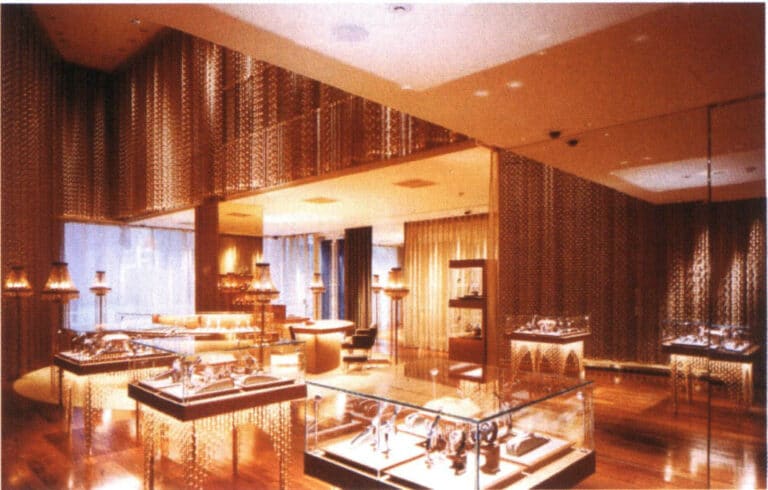
(1) The Significance of Exhibition Design
Exhibition design is a comprehensive art design, where designers use the planning of the layout, spatial design, lighting setup, color configuration, electronic media, and other means create an exhibition space that is artistically impactful and distinct in personality, presenting the exhibits to the audience in a way that allows them to joyfully, easily, and completely absorb the information about the exhibits. Therefore, the main focus is on the merchandise. The exhibition space has gradually formed alongside human development’s social, political, and economic stages. Within a defined time and spatial range, designers use artistic design language to create unique spatial dimensions by manipulating space and plane, conveying the intention of interpreting the exhibits, promoting the theme, and allowing the audience to participate, achieving the goal of perfect communication. This type of spatial form is generally referred to as exhibition space. The creative process of exhibition space is called exhibition design. From the exhibition’s ultimate purpose, the display’s effectiveness is the fundamental goal pursued by all exhibition activities.
In the 21st century, how humans communicate has changed tremendously, and people’s expectations for communication methods are also increasing. Traditional display venue is a basic need for exchanging products and corporate information. With the continuous development of technology and concept changes, utilizing space to convey information pleasantly is an important topic for exhibition designers. In modern exhibitions, the interaction between exhibitors and consumers has achieved good display effects. Currently, the exhibition model focusing on exhibitors must change, and more space and time will be given to consumers, who have become the design focal point.
(2) The Origin and Characteristics of Display in Human Psychological Activities
In nature, animals and plants often convey information through performances, exaggerations, dazzling displays, and demonstrations to achieve certain purposes. Humans are even more adept in this regard; early graffiti decorations, tattoos, modern clothing styles, and makeup all showcase various psychological personalities and needs. Therefore, display is an innate instinct in human psychological activities.
(3) The Role of Display in the Development of Future Society
In the future development of society, the experience economy will occupy an increasingly important position, and the experiences provided by exhibition spaces will be the focus of audience concern.
“The experience economy is the fourth stage of human economic forms following agricultural economy, industrial economy, and service economy. Consumption and services are no longer mechanical transaction processes; consumption venues have become theaters, and consumers have become participants and main actors. Experience enhances the added value of goods and services for sellers while bringing interest, knowledge, imagination, and memorable aesthetic experiences to buyers…” (Joseph Pine, 2016)
In exhibition design, designers use means such as shapes, lighting, colors, text, music, electronic media, and virtual reality systems to greatly expand and enrich the traditional connotation of exhibitions, placing more emphasis on the psychological experience brought to the audience by the design theme, and guiding people to participate more. This comprehensive experience in space is unattainable by other media. For this reason, exhibition design plays an increasingly important role (Figures 1-2, 1-3).

Figure 1-2 Live Model Display

Figure 1-3 Jewelry Display
2. The Essence of Exhibition Design
Display is a purposeful act, a form of communication activity, manifested as a temporal and spatial art, primarily affecting the economic and cultural fields. “Display” means “to see and be seen, to resolve the spatial manner of objects and events”; “Show” means “to point to and inform—communicate the information of objects and events.” Display is a visual act that occurs while walking and stopping.
Analyzing display from the perspective of information dissemination emphasizes the role of communication and bridging.
All displays are a form of communication and naturally conform to the main characteristics of information exchange. In 1948, American scholar Harold Lasswell proposed five basic elements that constitute the information process in his article “The Structure and Function of Communication in Society,” conducting a detailed study and summary of information activities’ general processes and elements. These five basic elements are:
(1) Who.
(2) Say what.
(3) In which channel?
(4) To whom.
(5) With what effect.
Because all five key elements in the English expression start with the letter “W,” it is referred to as the “5 W” model. This model is not complicated; it simply states that any information activity process consists of five parts: the subject of information dissemination, the content of the information, the channels of information dissemination, the target audience, and the effects of dissemination. Taking a clothing exhibition as an example, the “who” element refers to the manufacturers or distributors participating in the exhibition; “Say what” refers to the clothing styles, fabrics, and related information they present; “In which channel” refers to using exhibition halls or press conferences as media to disseminate their product information and image; “to whom” refers to the audience that the exhibitors intend to showcase and communicate with, namely consumers or potential consumers, which is the target group of the exhibitors; and “with what effect” refers to the consumption effects generated by the target customer group after visiting the exhibition. The combination of these five aspects or elements constitutes an information display activity. Of course, this classification method has certain limitations. Because it is a mode of unidirectional linear movement of information, it does not provide a feedback channel for the audience. Modern displays pay more attention to feedback on information, which makes the objective existence not a static, chain-like structure but a dynamic “ring” that circulates and repeats. In this, the ” chain ” ends are connected by the feedback system, forming a complete loop between manufacturers or distributors and consumers, allowing the original information sent by the information sender to be enriched and strengthening the closeness of this “ring.”
3. Characteristics of Display Design
(1) Authenticity
Display activities are generally conducted through physical exhibits as the content of the display because physical exhibits can more intuitively show the characteristics of the exhibits, making them more persuasive than abstract text and graphics. The audience can better and more effectively judge and choose through visual and tactile experiences (Figure 1-4).
(2) Multidimensionality
The venue, display equipment, exhibits, time, and audience are all basic display design elements. Although the exchange of information in modern society is no longer limited by venue, time, or country due to the development of the Internet, and the technology for virtual space displays has become increasingly sophisticated, the physical display in exhibition halls still holds necessity and vitality. In exhibition halls, exhibits can be directly touched and experienced, giving people an emotional understanding of the product’s brand concept. For the sensory experience of this human behavior, a real multidimensional space is the most suitable (Figure 1-5).
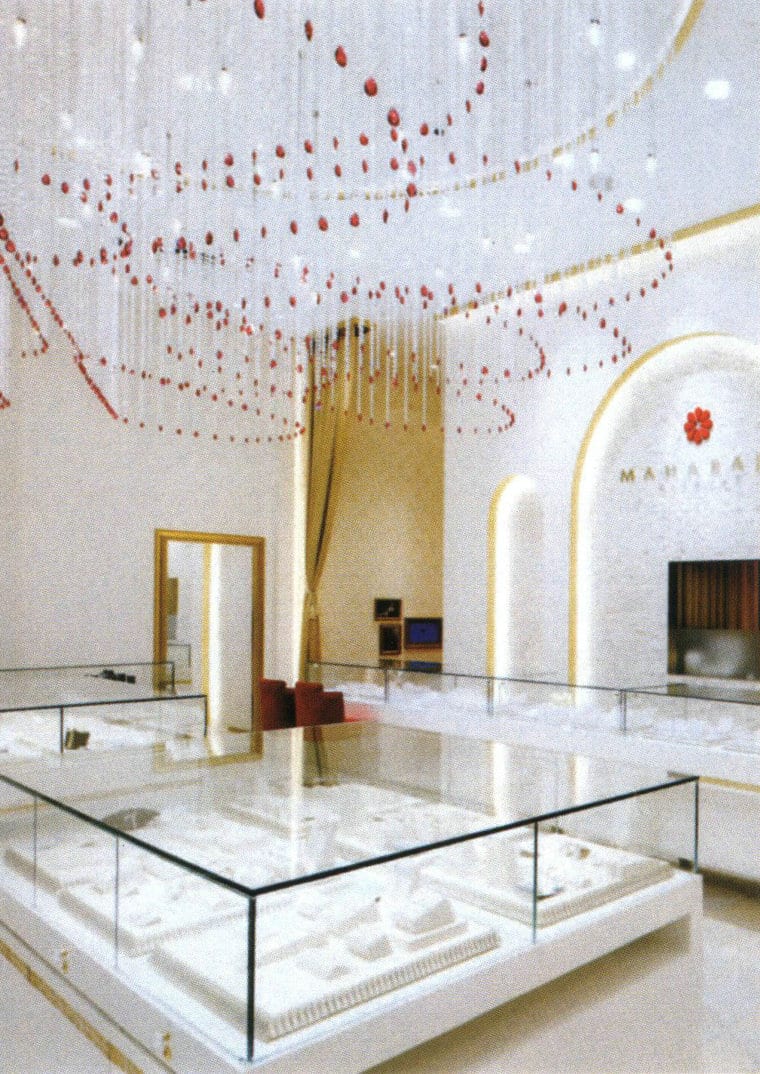
Figure 1-4 Physical Display Venue
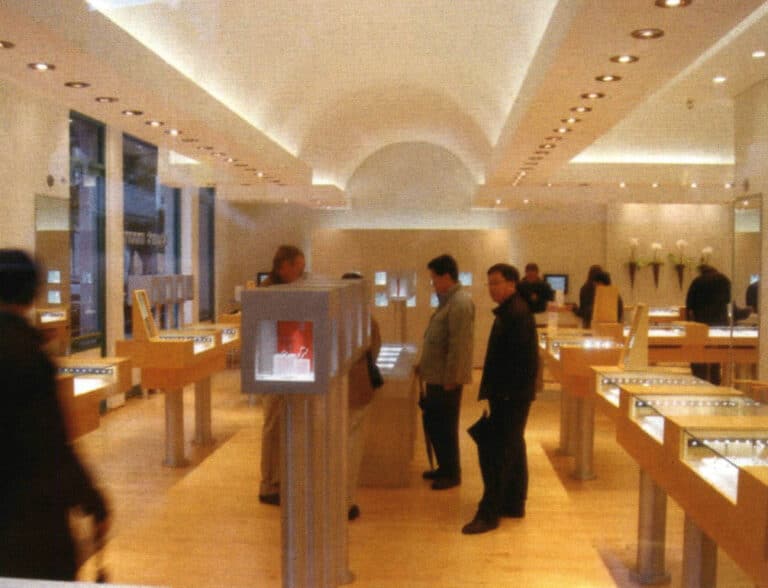
Figure 1-5 Multidimensional Display Space
(3) Scientific and Artistic Nature
The scientific nature of display design is reflected in the use of the latest technological means and in the ability to comprehensively apply knowledge from various disciplines such as information dissemination, marketing, and electronic engineering. The artistic nature of display design is manifested in the designer’s need to design and arrange the display space and exhibits according to the principles of aesthetic form, avoiding the simple stacking of items at will. By deeply understanding the audience and their exhibits and utilizing display props, designers can create a harmonious and unified display space with perfect visual effects through composition, combination, and configuration. The trends in the development of any art form and technological advancements can significantly impact modern display design.
(4) Economic Nature
Economic nature is the most effective means of seeking communication between enterprises and the market. Taking jewelry displays as an example, the cost of acquiring a customer through exhibition is far lower than other forms. Fashionable jewelry displays are becoming a new landscape in modern cities. Audiences gain a brand new experience, while for businesses, this is the most efficient form of promotion, and the win-win result becomes the best driving force for such displays (Figure 1-6).

4. Classification of Display Design (Figure 1-7)
(1) Classified by content are economic and trade displays, natural and cultural displays, thematic displays, professional displays, comprehensive displays, etc.
(2) Classified by form are expos, exhibitions, museum displays, science centers, heritage centers, memorial centers, nature conservation centers, showcase displays, etc.
(3) Classified by region, regional displays, national displays, international displays, etc.
(4) Classified by scale, there are small displays, medium displays, large displays, giant displays, etc.
(5) Classified by time are temporary, short-term, long-term, permanent, etc.
(6) Classified by activity method, there are fixed displays, mobile displays, touring displays, modular displays, etc.
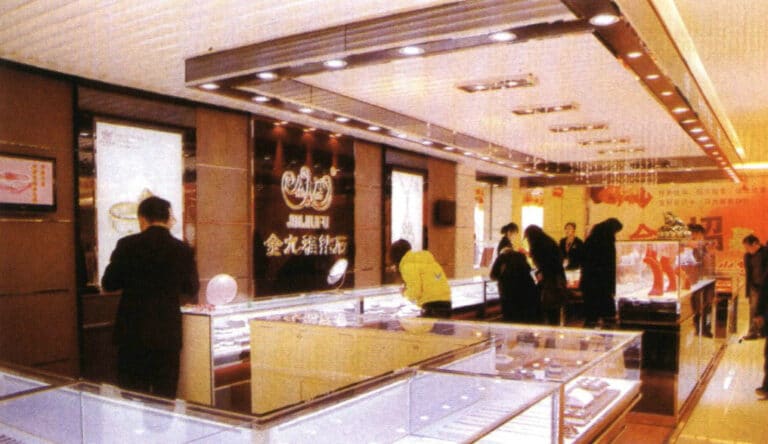
5. The Development of Display Design
(1) The Budding of Primitive Society
The earliest display activities of humanity can be traced back to ancient times, from the body painting and tattooing of primitive people to totem worship and religious worship, which, in a sense, are all purposeful display behaviors. Ancient temples, altars, and churches are places for displaying idols and other religious content; they serve as not only venues for display and appreciating religious idols and other religious content, but also important to rituals or religious activities. Moreover, many significant religious buildings are complete religious art museums, reflecting the development of religious history and religious art. The “Treasury” inside the ancient Greek Temple of Olympus housed various trophies and artworks, which modern people regard as a form of museum.
(2) Display in Commercial Activities of Feudal Society
As social productivity further improved, displays aimed at certain commercial purposes can be traced back to the ancient times of barter. At this time, the display and identification of goods became an important part of these activities. Consciously showcasing the quality of goods became a significant aspect. This exchange promoted the production and circulation of goods, gradually forming the earliest commercial environment— markets. In market trade, people could display their goods in designated areas for others to purchase and even create certain props for this display, such as using shelves to better showcase the products. China is an ancient civilization, and as early as the Shang and Zhou dynasties, merchants were specifically engaged in commercial activities. The “Along the River During the Qingming Festival” by Zhang Zeduan from the Song Dynasty vividly depicts a bustling market scene in the economically prosperous capital of the Northern Song Dynasty.
(3) Overview of Some World Expositions
In 1851, the first World Expo was held in London. Its main building was the Crystal Palace Exhibition Hall (Figure 1-8). It was constructed by assembling greenhouses, which set multiple precedents for exhibition design regarding materials, assembly methods, and display content. At that time, Britain was the first to enter the Industrial Revolution, with rapid political and economic development, earning the title of “the world’s factory.” To showcase its status as an industrial power, the first World Expo was held in Hyde Park, London, in 1851. This exhibition attracted the attention of many important figures of the time; it was proposed by the Royal Society of Arts, with Prince Albert, the husband of Queen Victoria, serving as the chairman. It adopted the design scheme of the Crystal Palace by gardener Joseph Paxton, which featured significant innovations in materials and construction methods. The “Crystal Palace,” constructed largely of steel and glass, covered a total area of 74000㎡ with a simple and clear shape that, aside from displaying the inherent texture of the materials, had no unnecessary decorations, reflecting a mechanical characteristic of industrial production. During this nearly six-month-long exhibition, it attracted over 6 million visitors and generated a profit of as much as £210,000. This novel format broke the inherent closed state of various producing countries at the time, allowing industrial production, design, and the public to interact through the medium of exhibitions, significantly impacting the modern concept of exhibitions. For more than a hundred years since then, each World Expo has become a grand event for showcasing and exchanging advanced materials, technologies, and ideas of the time, playing an important role in human progress.
The successful hosting of this World Expo (hereinafter referred to as the “Expo”) fully demonstrated Britain’s national strength and pioneered modern exhibition practices. Subsequently, developed industrial countries such as France and the United States followed suit, hosting various forms and large-scale international exhibitions, all of which achieved great success. France alone held five large World Expos in 1855, 1867, 1878, 1889, and 1900, respectively, with the famous Eiffel Tower (Figure 1-9) being the iconic building of the 1889 World Expo.
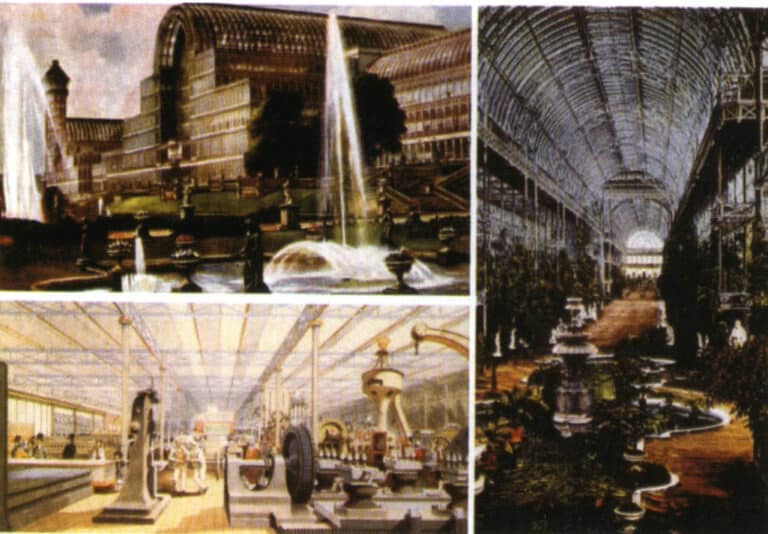
Figure 1-8 Crystal Palace, London
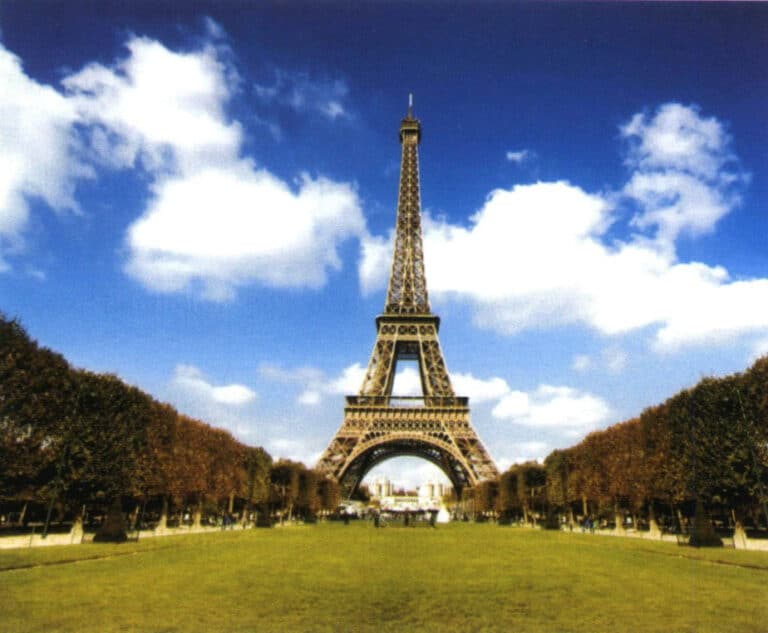
Figure 1-9 Eiffel Tower
At the 1893 World’s Fair in Chicago, the first demonstration of using an alternating current generator to power letters and graphics made from glass tubes to glow was showcased. The use of electricity and neon lights made this World’s Fair colorful and also provided a brand new design resource for future display designs (Figures 1-10 to 1-12).
The iconic Atomium was displayed at the 1958 Brussels World’s Fair, resembling an alien creature perched in Brussels. The Atomium is a building constructed by magnifying an iron molecule 1651 times, standing 102 meters tall, composed of 9 spheres with a diameter of 18 meters and metal tubes with a diameter of 3.3 meters and a length of 26 meters. This building attracts visitors from all over the world every year (Figure 1-13).
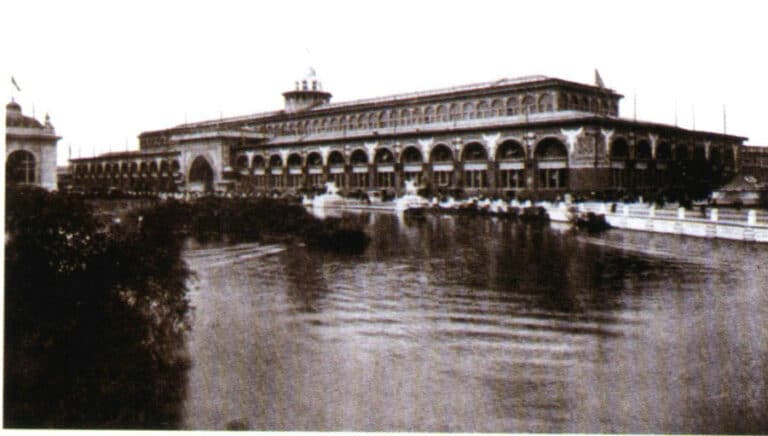
Figure 1-10 Scene one from the 1893 World's Fair in Chicago

Figure 1-11 Scene two of the 1893 Chicago World's Fair
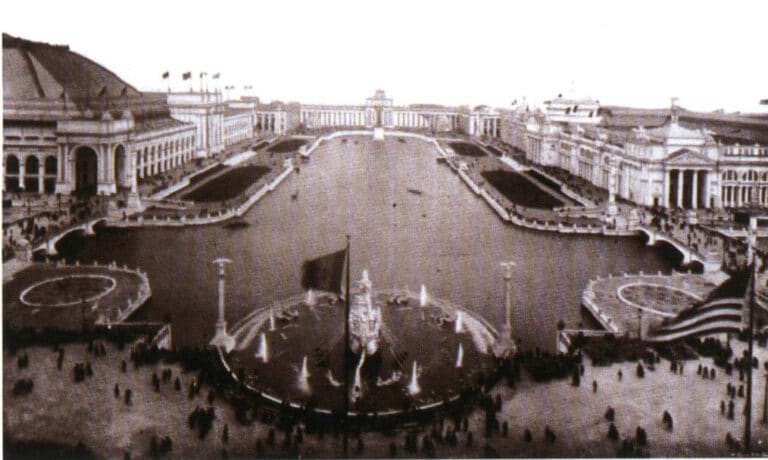
Figure 1-12 Scene three of the 1893 Chicago World's Fair
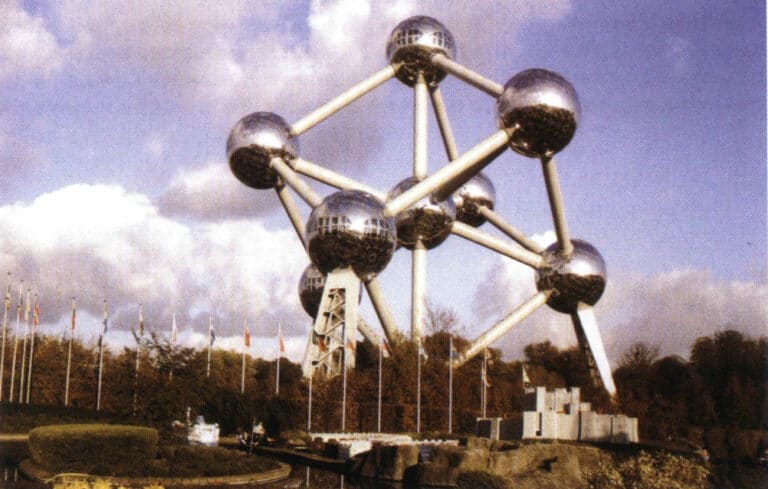
Figure 1-13 The Atomium in Brussels
In 1964, the Disney theme park was showcased for the first time at the New York World’s Fair, attracting thousands of children worldwide to visit the amusement rides (Figure 1-14).
The China Pavilion was the iconic building of the World Expo held in Shanghai, China, in 2010 (Figure 1-15).

Figure 1-14 Disney Theme Park

Figure 1-15 China Pavilion
Section II Overview of Jewelry Display Design
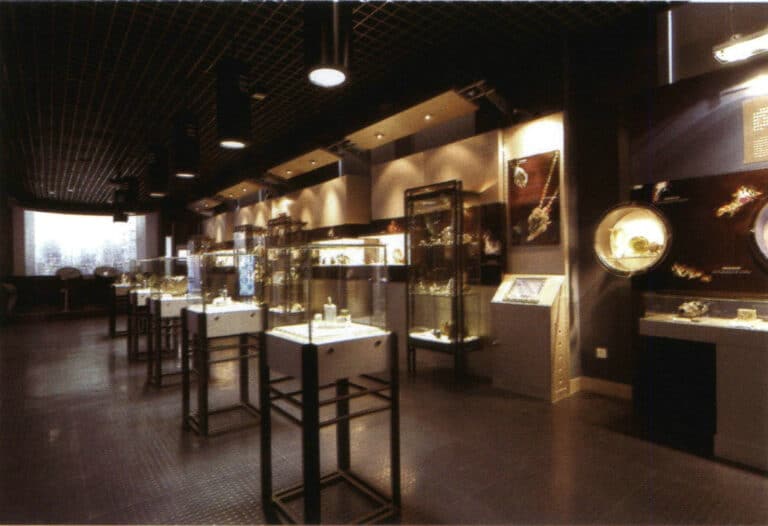
Section III Principles of Jewelry Display Design
1. Formal Rules in Jewelry Display Design
Display space design is a form of visual art that must be embodied in specific visual forms and strive to provide a sense of beauty. The display space primarily comprises elements such as space, exhibits, display tools, color, lighting, and materials, creating an overall environment. Arranging and handling these elements can produce very good visual effects. Display designers must master and apply certain basic formal rules of artistic beauty, mainly dominance and emphasis, symmetry and balance, contrast and harmony, rhythm and cadence, proportion and scale.
(1) Dominance and Emphasis
In a whole composed of several elements, the proportion and position of each element within the whole will affect the structure and unity of the whole. Each element should reflect the difference between the main and secondary, using a “visual center” as the focal point to avoid the space becoming too bland and loose, thus losing its unity (Figure 1-17, Figure 1-18).
(2) Symmetry and Balance
Symmetry, in functional terms, can achieve a balance of forces. Visually, it conveys a sense of solemnity, elegance, stability, and order. Due to the correspondence in its shape, it is uniform and creates a strong overall impression, making it easy to recognize. In display spaces, symmetrical techniques are often used, but if not handled properly, they can easily feel rigid, static, and monotonous (Figure 1-17).

Figure 1-17 "Sun God Bird" Display

Figure 1-18 Window Display
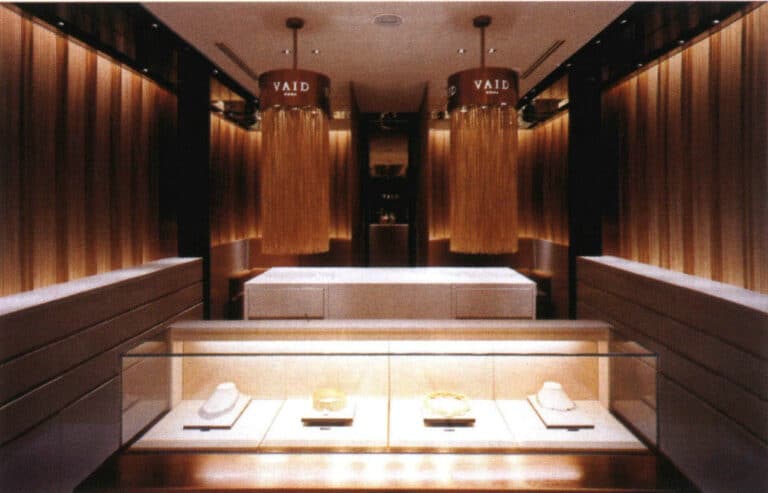
Figure 1-19 The symmetrical display on both sides reflects a sense of solemnity and elegance
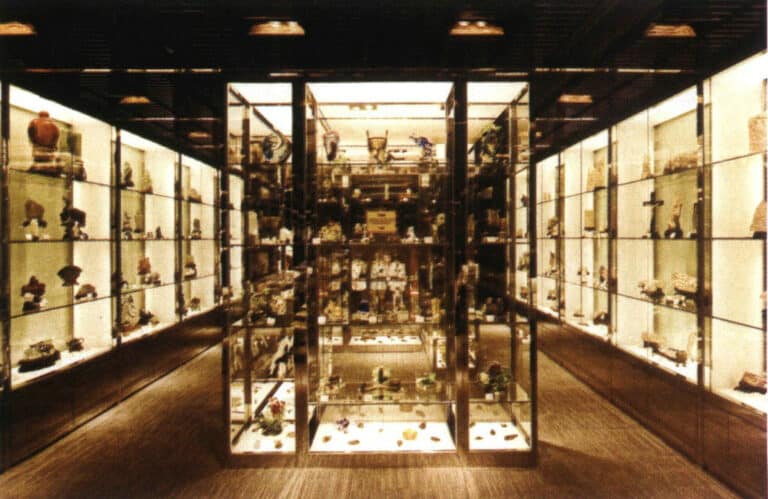
Figure 1-20 The balanced display design technique
(3) Contrast and Harmony
Contrast, the most active and positive factor in design, is the juxtaposition of two or more objects with differences but with some connection to form a gap and reflect the characteristics. The contrast method is widely used in exhibition spaces, including form, texture, color, directional, scale, etc. Properly handling these contrasting relationships can make the entire space lively and vivid.
Harmony refers to the method of organizing two elements that are similar in nature but different in volume or different in nature but similar in volume to create a sense of coordination. In spatial expression, it is reflected as harmony of form, harmony of tone, etc.
Contrast and harmony complement each other in exhibition spaces and can be individually emphasized or coexist. Contrast can make the visual effect of the space lively and pleasing to the eye; harmony can create a stable and unified aesthetic feeling for visitors, enhancing each other (Figure 1-21).
(4) Rhythm and Cadence
Rhythm and cadence are formed through repeated structural forms, creating regular variations in size, position, color, etc., which psychologically generate a rhythmic and melodious visual aesthetic for the viewers. Specific forms of expression include continuity, gradient, fluctuation, interlacing, etc. (Figure 1-22).
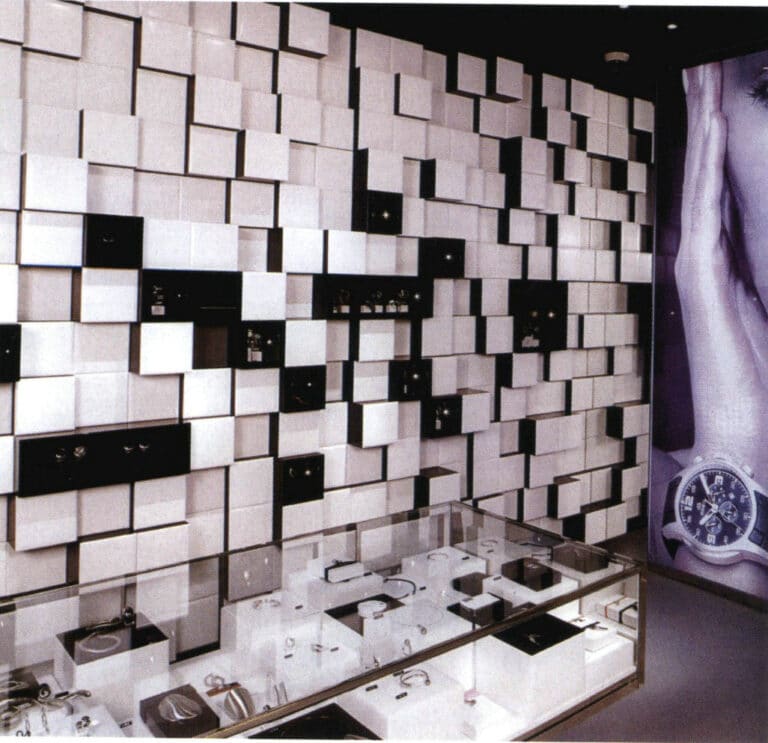
Figures 1-21 Showcase the luxury of jewelry through the black-and-white contrast design technique

Figure 1-22 Swarovski Store
(5) Proportion and Scale
For a long time, people have been trying to find proportion relationships that conform to aesthetics. The factors that constitute proportion are influenced by materials, functions, structures, and culture, among other aspects. Spatial scale studies the relationship between space’s perceived size and actual size. People often obtain a sense of overall spatial scale through comparison, using the sizes of local components and long-formed experiences. In exhibition spaces, the spatial scale required for different exhibits is also not the same (Figure 1-23).
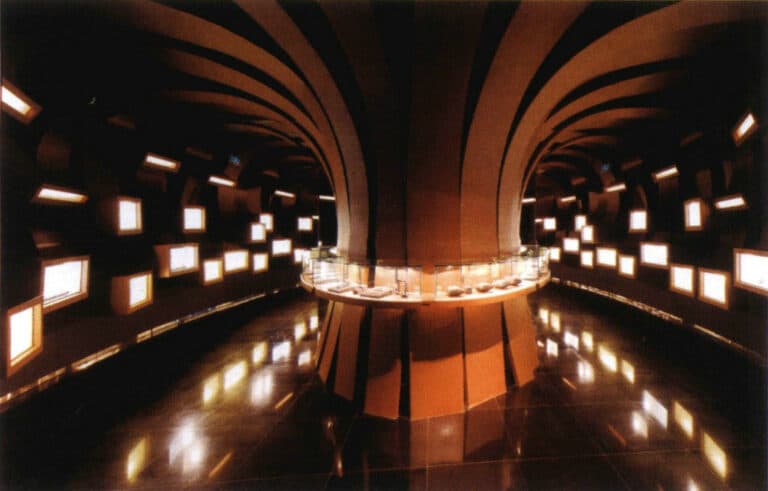
2. Ergonomics in Jewelry Display Design
Ergonomics, also known as human factors or human-machine interaction, is based on human measurements and proposes design specifications regarding visual, mobility, and psychological responses. Ergonomics studies various factors such as anatomy, physiology, and psychology of people in a certain work environment, examining the interaction between humans and artificial objects as well as the environment, and addressing issues of health, safety, and comfort in work, home life, and leisure. The research aims to seek “comfort + efficiency + beauty.” From the perspective of exhibition space, the main function of ergonomics is to make the space environment suitable for human needs through a correct understanding of physiological and psychological factors.
(1) Exhibition Scale
Analyzing the characteristics of exhibition activities, scale-related behaviors mainly involve walking and viewing. Therefore, the scale of exhibition space, props, and exhibits should be organized, designed, and displayed based on the absolute dimensions of the human body. The scale formed by the range of human activities and modes of behavior is the standard for defining the scale of exhibition design.
The basic scale in exhibition design is reflected in aisle width, display density, and display height.
① Aisle Width
The aisle width in general exhibition spaces is calculated based on the number of streams of people, with each stream calculated at 60 cm. The narrowest aisle must ensure it can accommodate two streams of people passing through. The aisle dimensions around a circular platform should be at least 200 cm; otherwise, it will cause congestion (Figure 1-24).
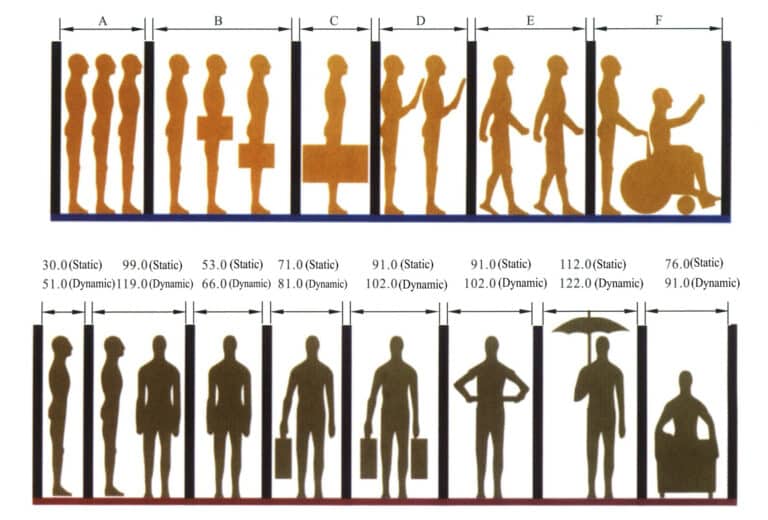
② Display Density
The display density refers to the percentage of the exhibition space occupied by the displayed objects. If the display density is too high, it can cause congestion among visitors, leading to crowding and tension, resulting in fatigue and affecting the effectiveness of communication and transmission of the exhibition. Conversely, if the display density is too low, the exhibition space may appear empty and lacking, reducing the utilization of the space. Generally, the percentage of exhibition space occupied by the displayed objects should be between 30%~40%.
③ Display Height
In terms of vertical display areas, the display height is generally between 80~250cm. The optimal visual area for a person is within a 60cm horizontal range of 20 cm above and 40 cm below the eye level. If we consider the average height measurement in our country to be 168 cm, the horizontal eye level is approximately 150 cm, and the best display height should be between 125~185cm. The space below 80 cm from the ground can be a display area for large exhibits (Figures 1-25, 1-26).

Gambar 1-25 Dimensi Tampilan Etalase Layar (Satuan: mm)
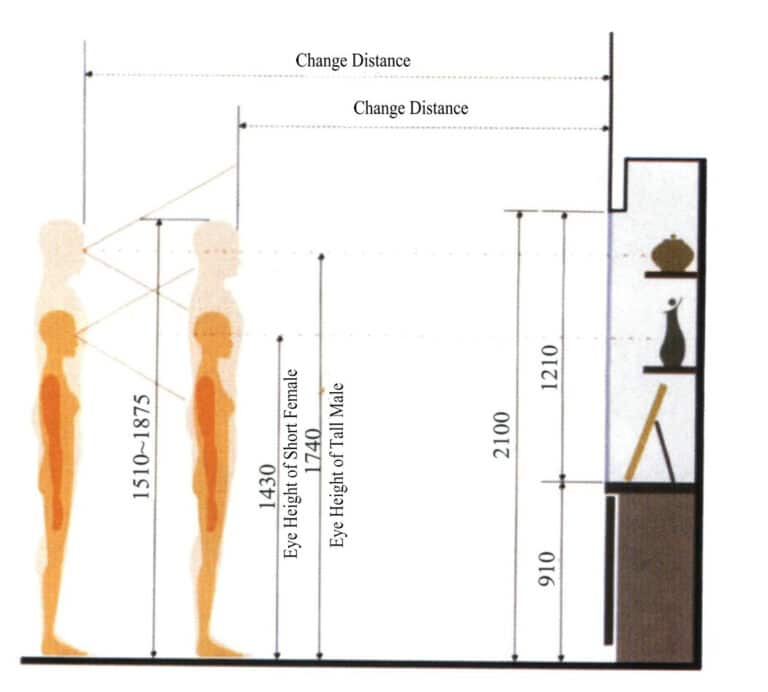
Figure 1-26 Display Showcase Scale (Unit: mm)
(2) Visual Scale
Vision is humans’ most important perceptual ability, and the effectiveness of information transmission in displays mainly depends on visual factors. Therefore, it is necessary to understand and study the visual characteristics of people and apply them to display design.Visual characteristics and apply them to display design.
① Field of View Scale
The field of view scale refers to the spatial range a person can see when their head and eyes are fixed. The field of view includes two forms: the general field of view and the color vision field. The general field of view refers to the visual range of the human eye, which is about 15 degrees (in horizontal or vertical direction), where its resolution capability is the strongest. Thus, it can be seen that the optimal visual area of the human eye is limited.
A person’s color perception is produced by the different wavelengths of light stimulating the retina in various ways. The ability of the human eye to recognize different colors is called color vision. The maximum field of color vision is white, followed by yellow, while blue and green have the smallest fields. The color vision field is related to the color of the viewed object and the contrast produced by its background color (Figures 1-27, 1-28).

Figure 1-27 The field of vision and its values within the horizontal plane of the human eye
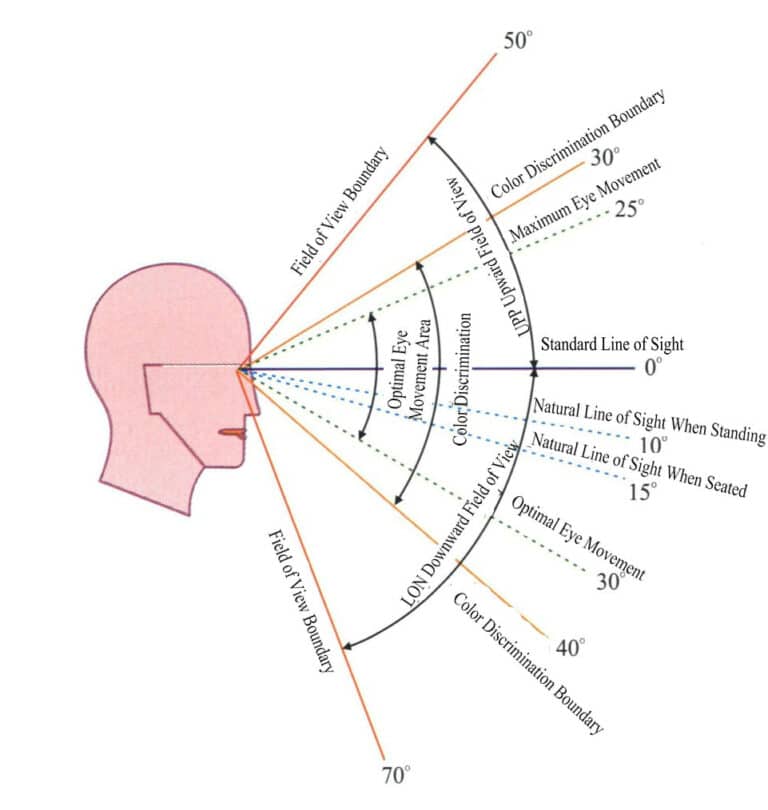
Figure 1-28 The field of view of the human eye in the vertical plane and its values
② Angle Scale
The angle of view refers to the angle at which the light from both ends of the viewed object intersects the eye, which is related to the viewing distance and the distance between the two points of the object being viewed. The horizontal (left and right) and vertical (up and down) angles of view for a person are general 60°, and the angle of view is one of the important criteria for determining the size and standard of different visual images in display design.
③ Viewing Distance Scale
The viewing distance scale refers to the distance between the observer’s eyes and the object being viewed, generally 1.5 to 2 times of the exhibit scale is preferable. When people observe fine and delicate items such as watches and jewelry, the viewing distance naturally needs to be close, while for larger items, one must step back to a distance of 2~4 times their scale to see the whole picture. In addition, the viewing distance is directly proportional to the illumination value; a higher brightness increases the viewing distance, while a lower brightness decreases it.
The central visual angle of the human eye within 10° constitutes the optimal visual zone, where visual recognition capability is strongest.
Within 20° of the central visual angle lies the transient visual zone, where objects can be identified within a short time span.
The central visual angle spanning 30° represents the effective visual zone, requiring focused attention to recognize objects.
The maximum visual zone extends to 120° around the central visual angle. Objects at the periphery of this zone demand considerable attention for clear identification. When head movement is involved, the maximum visual range can expand to approximately 220° (Figure 1-29).
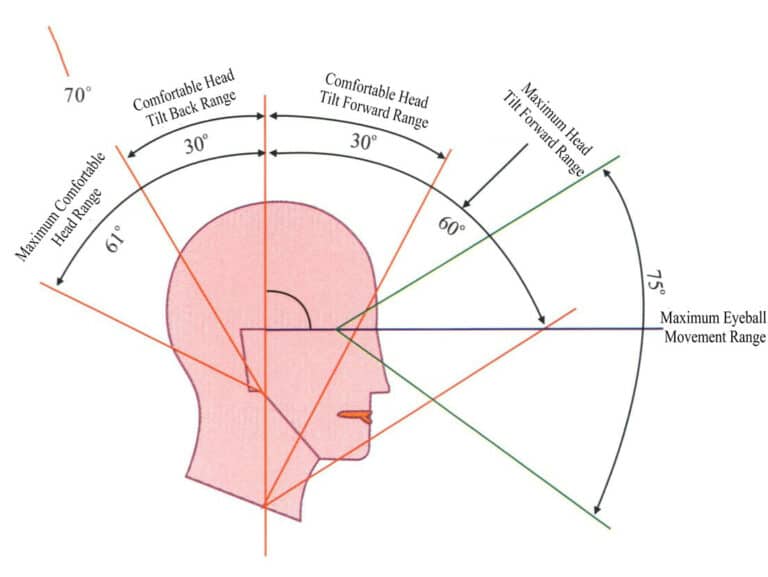
(3) Psychological Scale
Psychology is the science that studies mental activities and their laws. Everyone has an invisible psychological scale that determines people’s emotions, such as joy, anger, sorrow, and happiness. In the process of understanding things, people may experience feelings of satisfaction, preferences, fear, and other psychological emotions, all of which can influence their actions, such as whether they will actively seek to understand the exhibits or have the desire to purchase the exhibits. Therefore, applying psychological scales in exhibition design plays a significant role and is very important for the entire display (Figures 1-30 to 1-34).
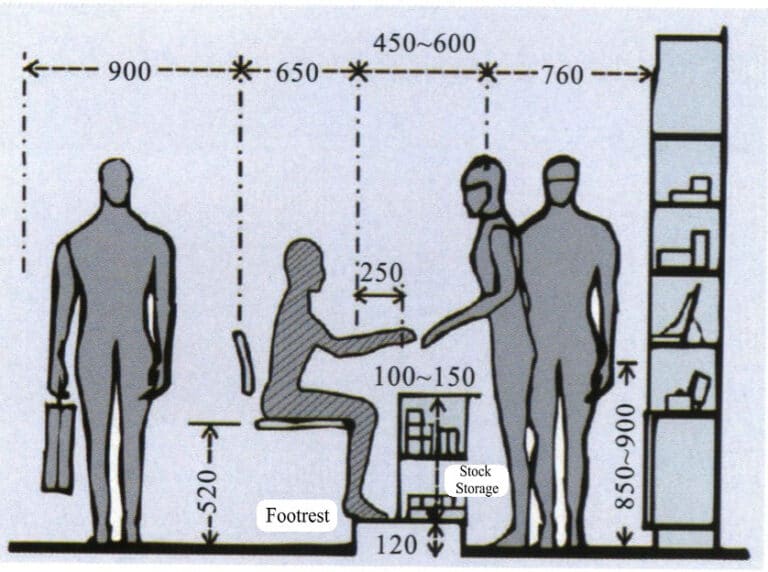
Figure 1-30 The optimal counter height for customers sitting while purchasing jewelry (unit: mm)
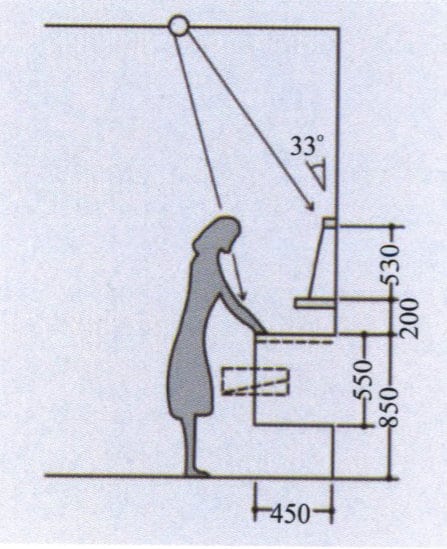
Figure 1-31 The optimal counter height for customers standing while purchasing jewelry (unit: mm)

Figure 1-32 The best line of sight for customers standing at the slanted display cabinet (Unit: mm)
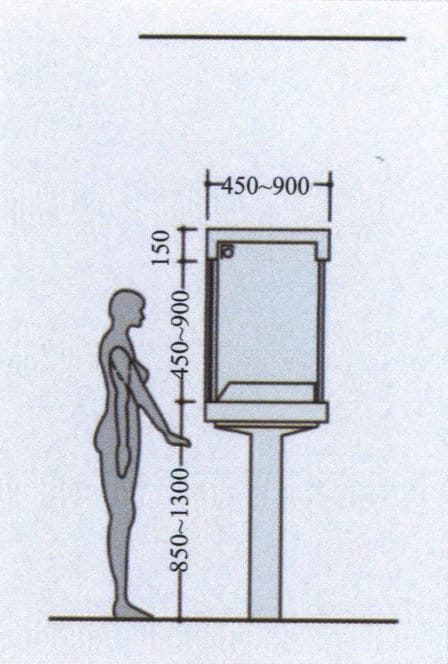
Figure 1-33 Optimal line of sight for a customer standing at a stand-alone display case (in mm)
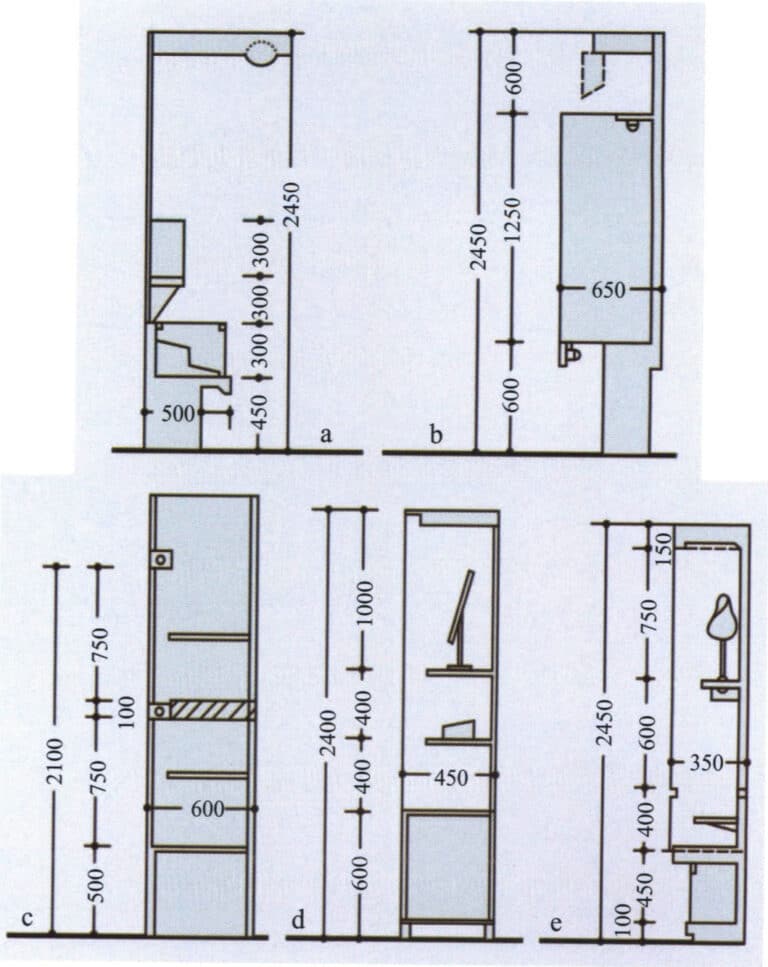
Copywrite @ Sobling.Jewelry - Produsen perhiasan khusus, pabrik perhiasan OEM dan ODM
Section IV The Connotation of Jewelry Display Design
1. The Design and Use of Jewelry Display Props

(1) Display Cabinet
A display cabinet is an exhibit that protects and highlights important items. Display cabinets typically include upright cabinets (set against a wall), table cabinets (desk-style flat cabinets with a horizontal or sloped glass cover on top), and open-access display cabinets. Display cabinets are generally made with wooden or metal frames and supports, enclosed with glass and panels.
① Upright Cabinet
In modern exhibition space design, prefabricated tall and central display cabinets are commonly used. The vertical and horizontal components of the cabinets have grooves for inserting glass; there are also spring steel clips for holding the glass. If the central cabinet is placed in the middle of the exhibition hall, it must be surrounded by glass. Only the back panel must be installed if it is placed against a wall. Additionally, according to needs, a light source can be added to the top of the tall cabinet, using frosted glass or metal grilles to diffuse the light evenly. The lighting can illuminate the exhibits using energy-saving or spotlight lamps, but a ventilation and heat dissipation device must be included. The height of the tall cabinet is usually 200~240cm, the width is 80~120cm, and the depth is 40~80cm (Figures 1-36 to 1-41).
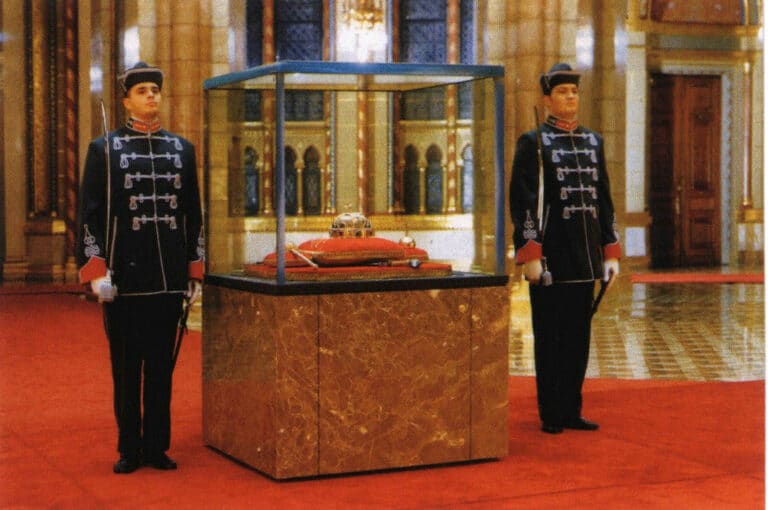
Figure 1-36 Independent display cabinet
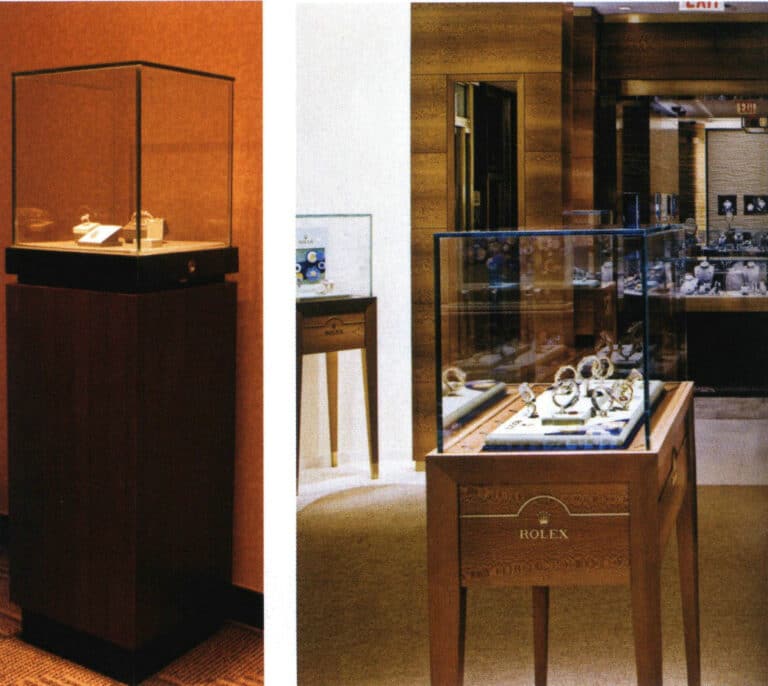
Figure 1-37 Independent display cabinet (1)
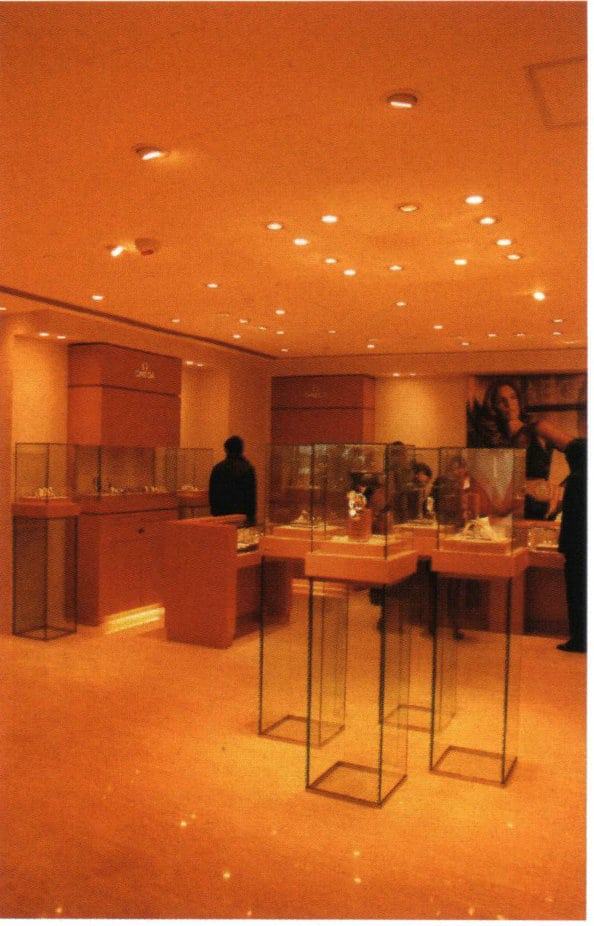
Figure 1-39 Combination of Independent Display Cabinets
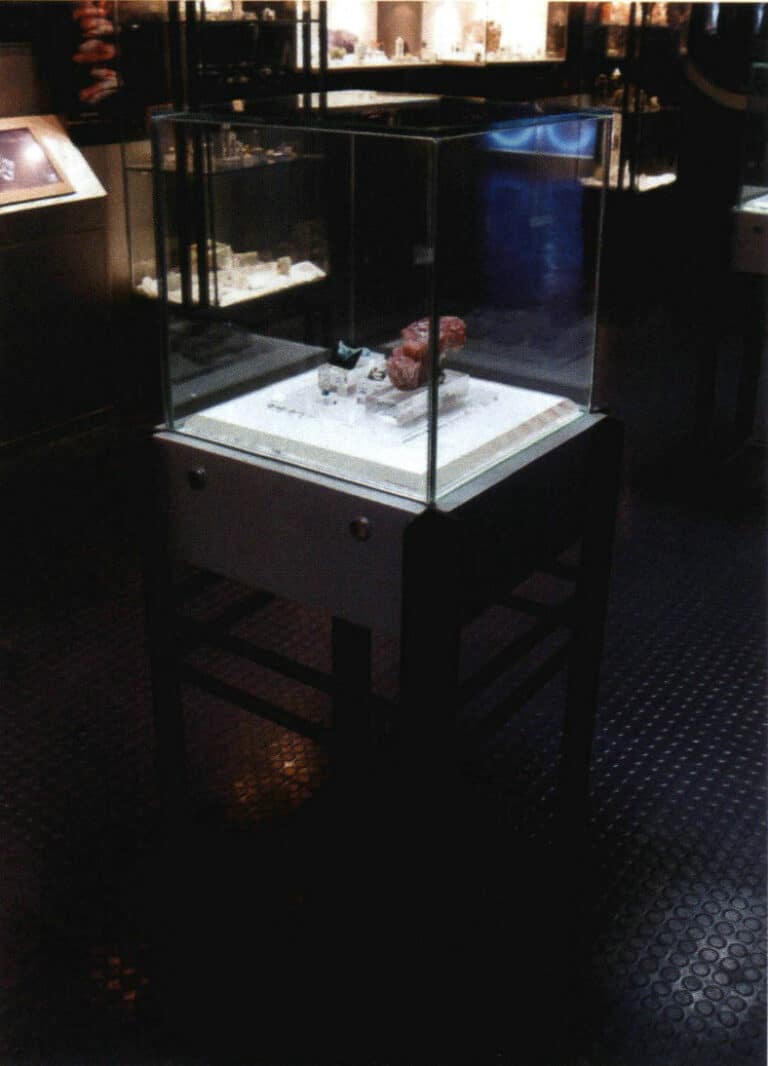
Figure 1-40 Independent Display Cabinet (3)

② Open-access Display Cabinet
A open-access display cabinet is a showcase designed to be viewed from only one side, resembling a window display. Various scenes can be set up inside, placing the exhibits in a simulated environment and presenting vivid and realistic visual effects. The depth of a large open-access display cabinet should be at least 1/2 its width, and the lighting design should also be emphasized to highlight the exhibits. The general height of a display cabinet is 180~250cm, the depth is 90~150cm, and the length can be determined based on actual needs (Figures 1-42 to 1-44).
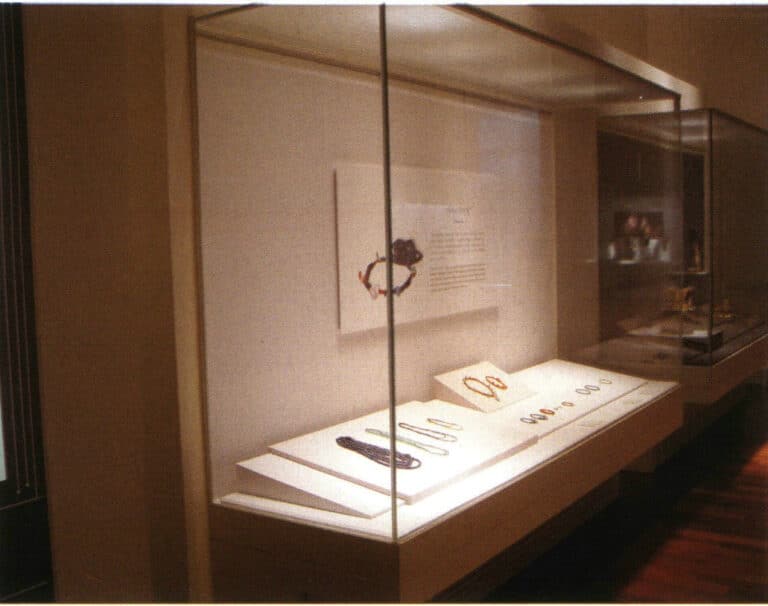
Figure 1-42 Museum display case for jewelry
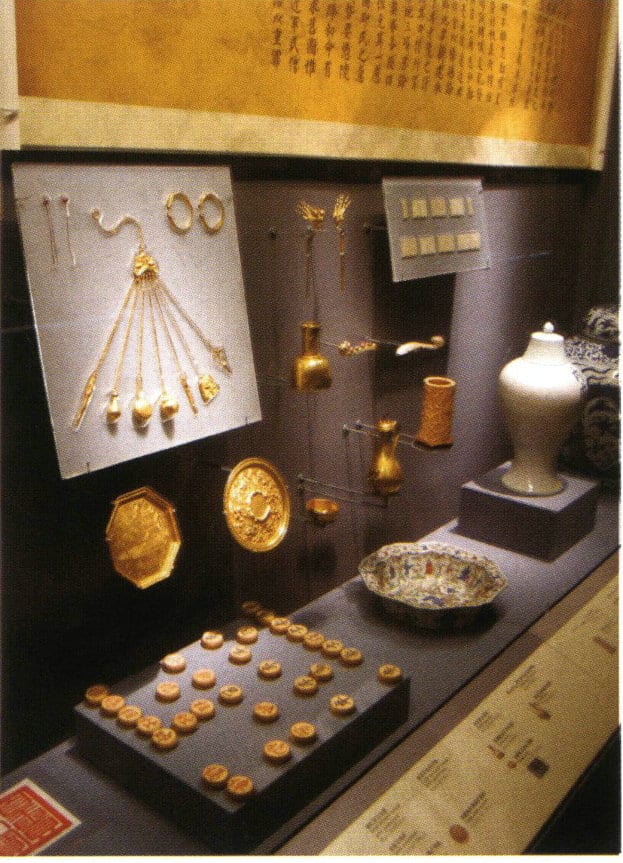
Figure 1-43 Glass display case for gold and silverware
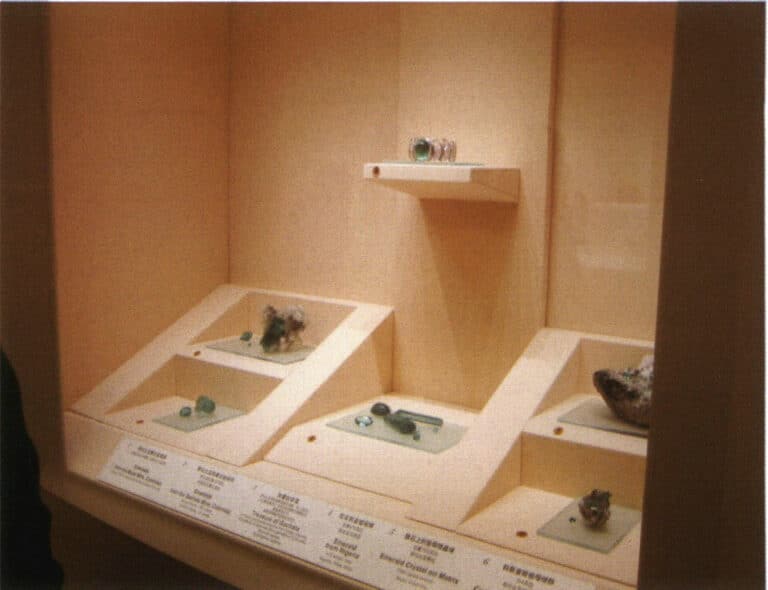
③ Table Cabinet
Table cabinets typically come in two types: flat and slanted, with slanted cabinets further divided into single and double slants. Single-slant cabinets are usually placed against a wall, while double-slant cabinets are positioned in the center of the exhibition hall. Table cabinets can be equipped with small metal halide spotlights inside, but they need anti-glare concealment; fluorescent lights can also be set at the bottom or sides, with the surface using frosted glass or milky plastic sheets for even light distribution. The dimensions of table cabinets are usually: the total height of flat cabinets is 105~120cm, and the total height of slanted cabinets is approximately 140 cm, with a width of 120~140cm, depth of 50~90cm, and net height of 20~40cm inside the cabinet (Figures 1-45 to 1-47).

Figure 1-45 Flat table cabinet
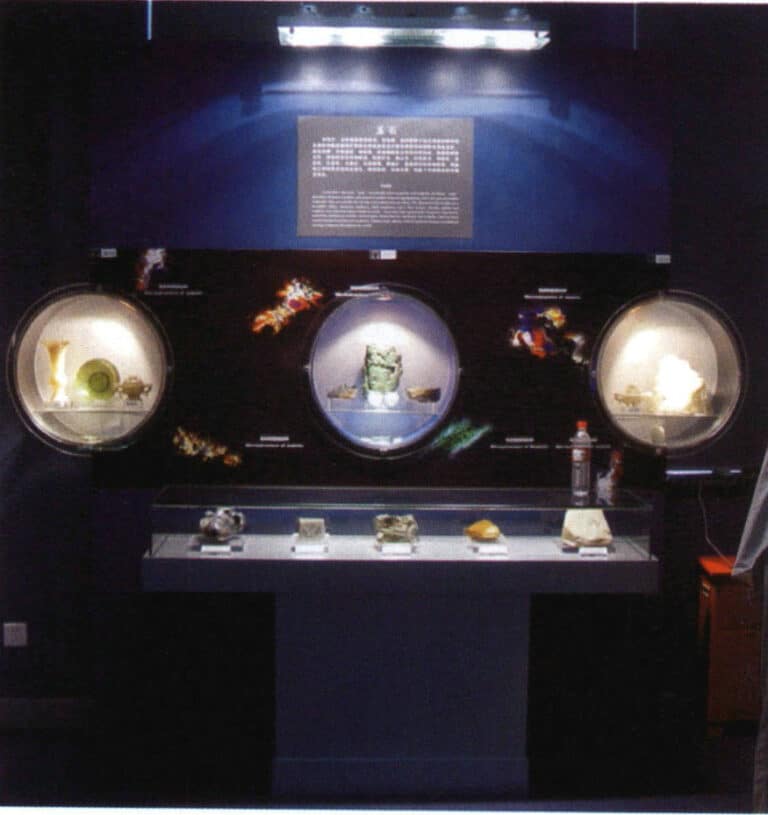
Figure 1-46 Flat table cabinet (1)
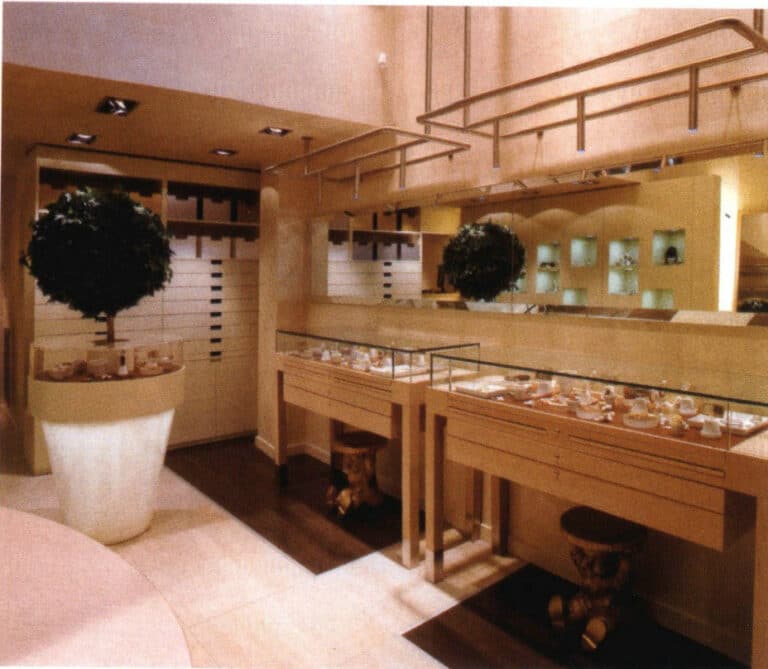
④ Niche
A niche is left in the wall as a space for displaying exhibits, with hidden lights on both sides to create a hazy effect, like a veil for the decorations inside. Lighting can also be set above the opening to fully showcase the display items’ overall appearance.
The focus of the niche decoration is around the outer edge of the wall opening, creating a feeling similar to a picture frame, using various forms of frames to highlight the beauty of the space inside the opening, thus showcasing a cultural fashion. Of course it can also be done on the wall opening, which also creates a certain sense of novelty. Although the wall structure limits the depth of the niche, it does not occupy a building area, making it relatively convenient to use, and it is often favored by exhibition designers (Figure 1-48 to Figure 1-51).
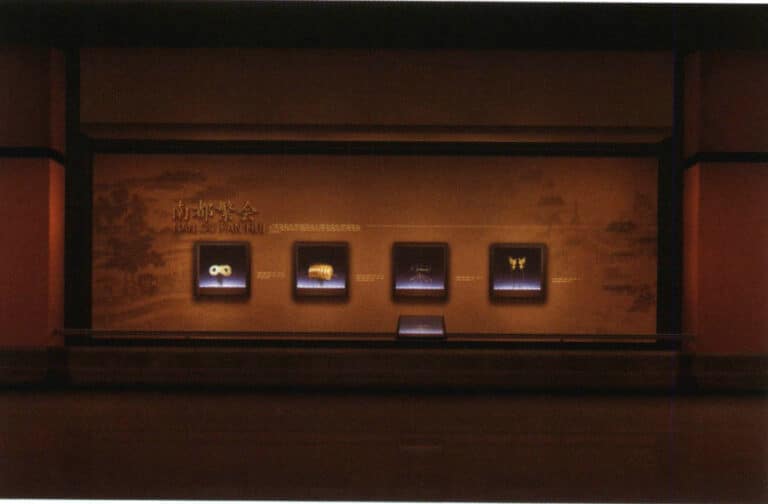
Figure 1-48 Jewelry display at the Nanjing Museum

Figure 1-49 Jewelry display at a jewelry specialty store
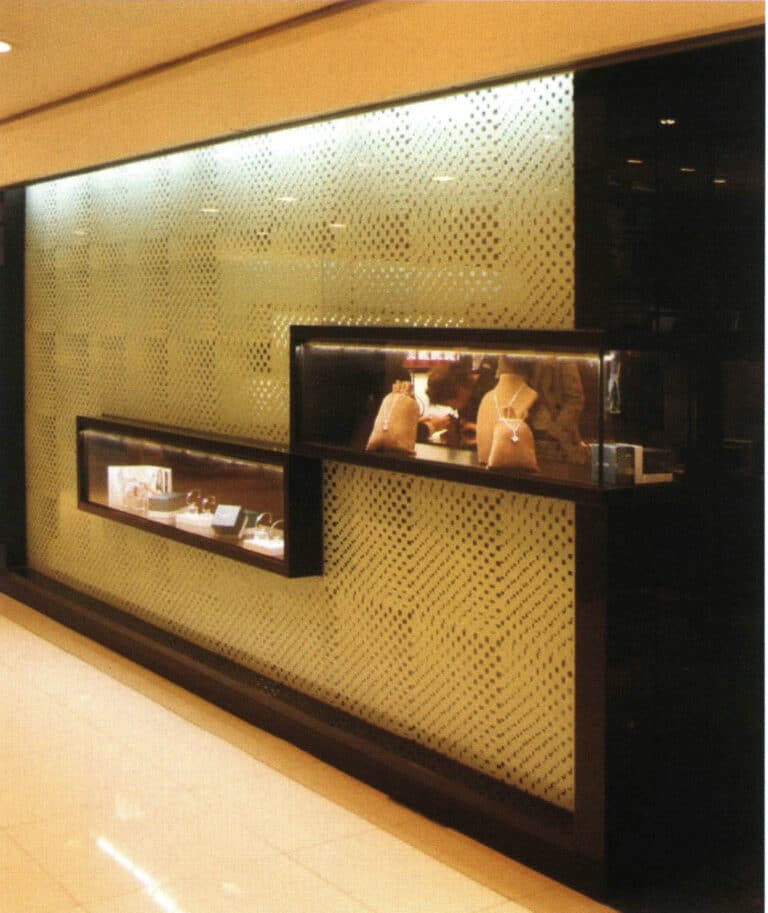
Figure 1-50 Jewelry showcase display (1)

Figure 1-51 Jewelry showcase display (2)
(2) Display Stand
The display stand is the equipment used to place and showcase exhibits. Its shape, color, material, and volume play an important role in the “character” and “expression” of the display space. There are various styles of display stands, which can be large or small, high or low. Display stands can be categorized as block-type or platform-type (Figure 1-52, Figure 1-53).
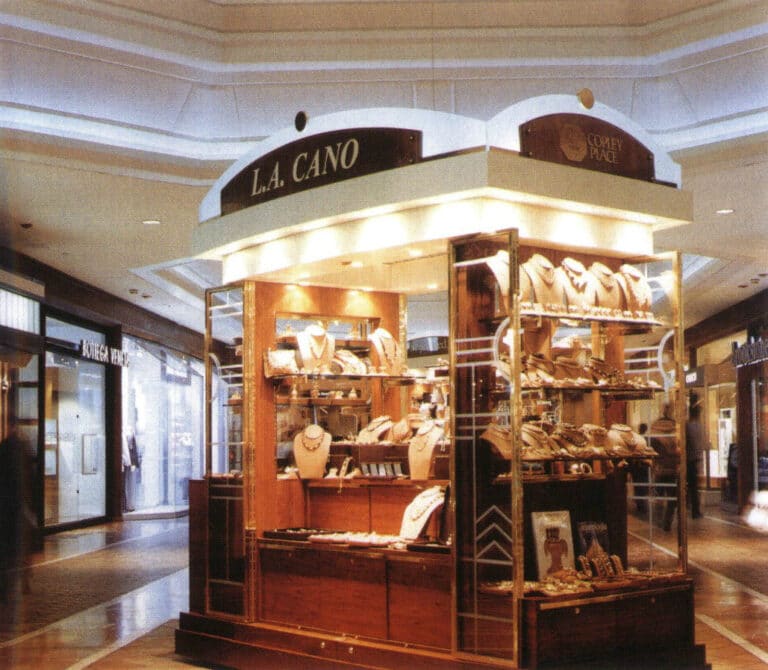
Figure 1-52 Three-dimensional display stand display
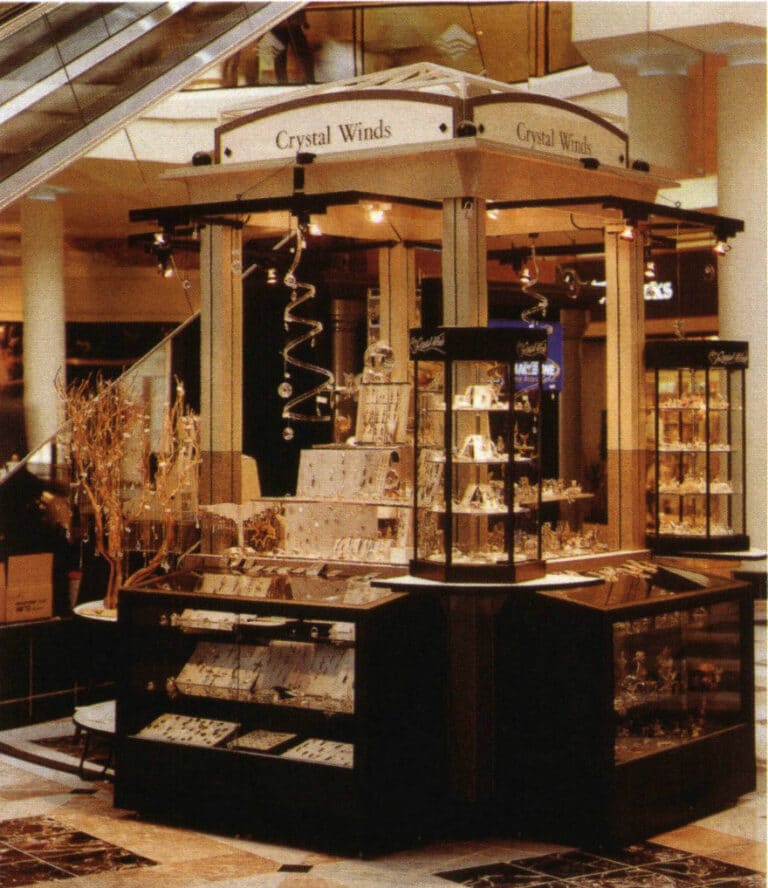
Figure 1-53 Diversity of Three-Dimensional Display Stands
(3) Display Shelf
The display shelf is a supportive framework for hanging, supporting display boards, or assembling display stands, display cabinets, and other forms. It can also be used as a partition, ceiling, or for other complex three-dimensional shapes (Figures 1-54 to 1-56).
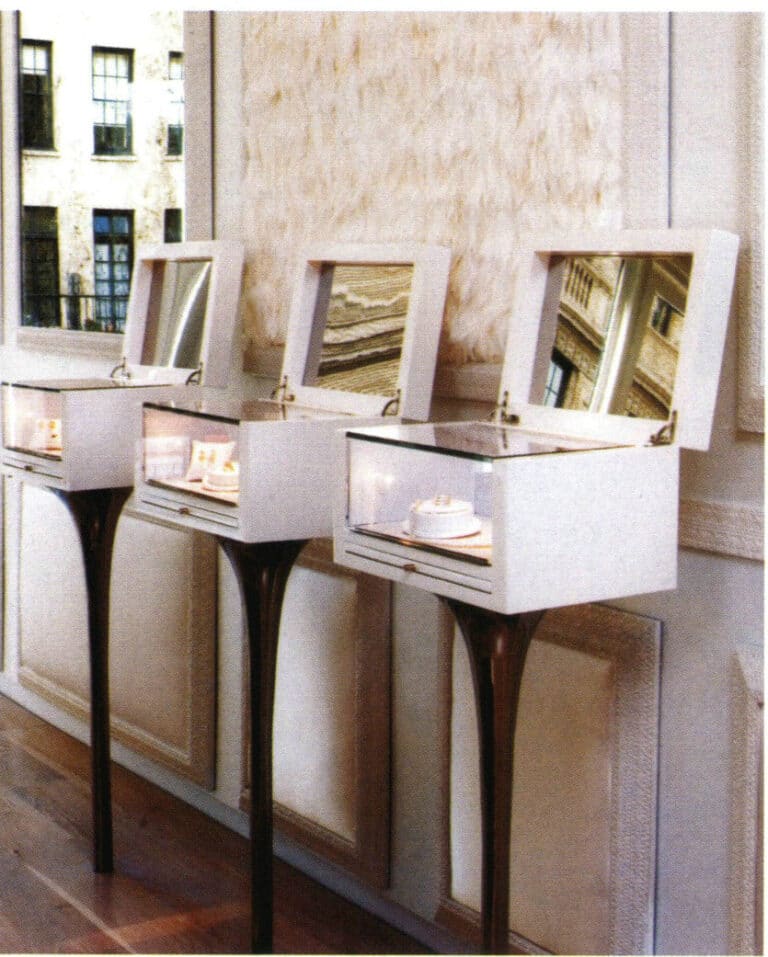
Figure 1-54 Shaped Display Shelf
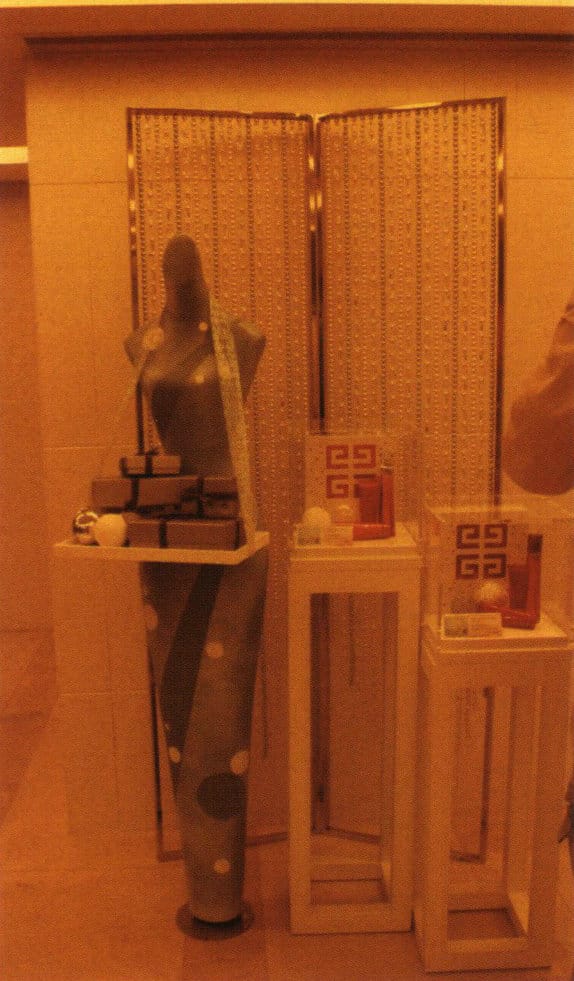
Figure 1-55 Display shelf with scene creation
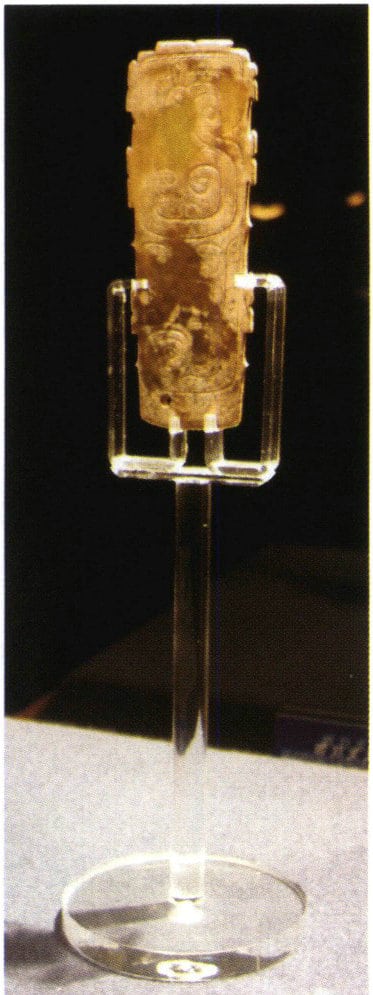
Figure 1-56 Transparent display shelf
(4) Display Board
The display board is a display device that presents images and explanatory text, primarily in a flat shape. The display board can be fixed to a display rack, stand upright on the ground, or be hung on a wall, occupying a small area and saving space (Figure 1-57, Figure 1-58).

Figure 1-57 The display board will highlight the theme identification
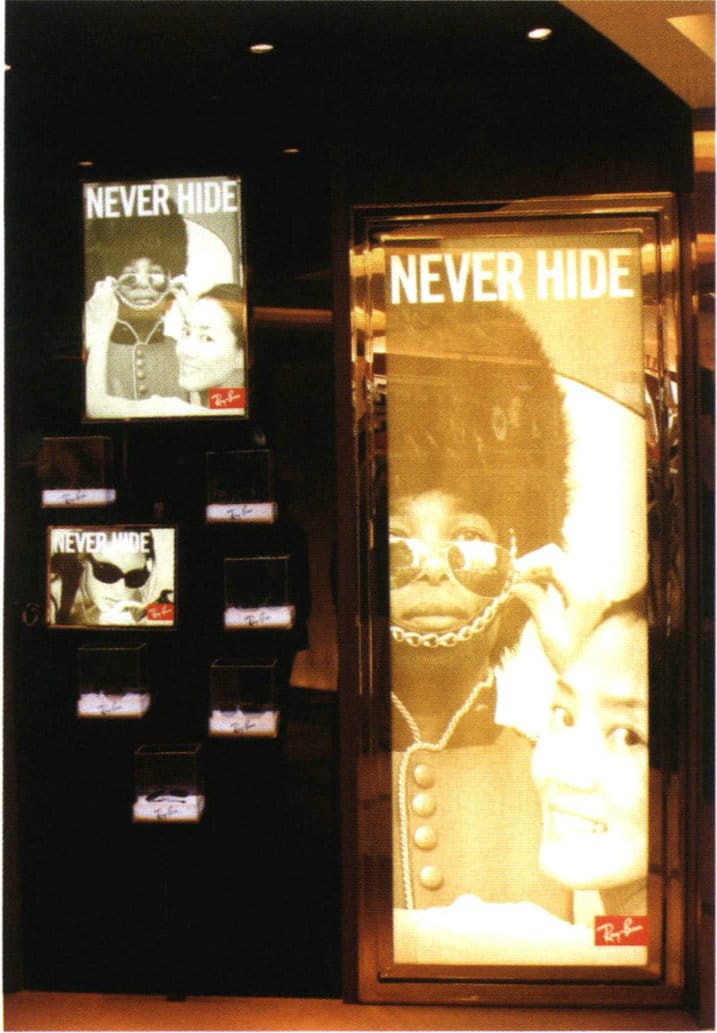
Figure 1-58 The display board will combine posters and physical objects for presentation
(5) Auxiliary Display Equipment
In the design of exhibition spaces, small display equipment is often used, such as small building blocks for exhibits, display signs, jewelry boxes, etc. Although these small display items are not large and come in various forms, each serves a specific function and is often an indispensable part of the display. The design or selection of their shape, color, specifications, and dimensions depends on factors such as the style of the exhibition environment, scale, nature of the display, characteristics of the exhibits, and the color tone of the exhibition space (Figures 1-59 to 1-68).
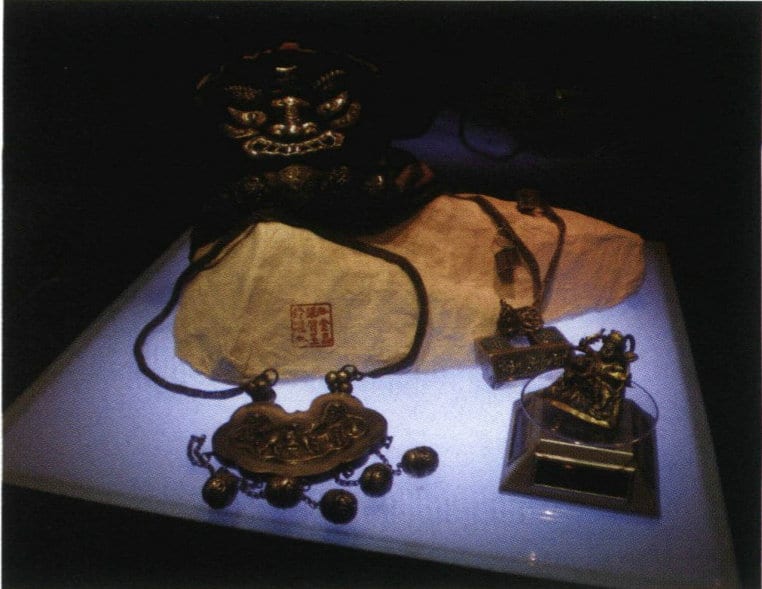
Figure 1-59 Mountain-shaped block display

Figure 1-60 Slanted area block display
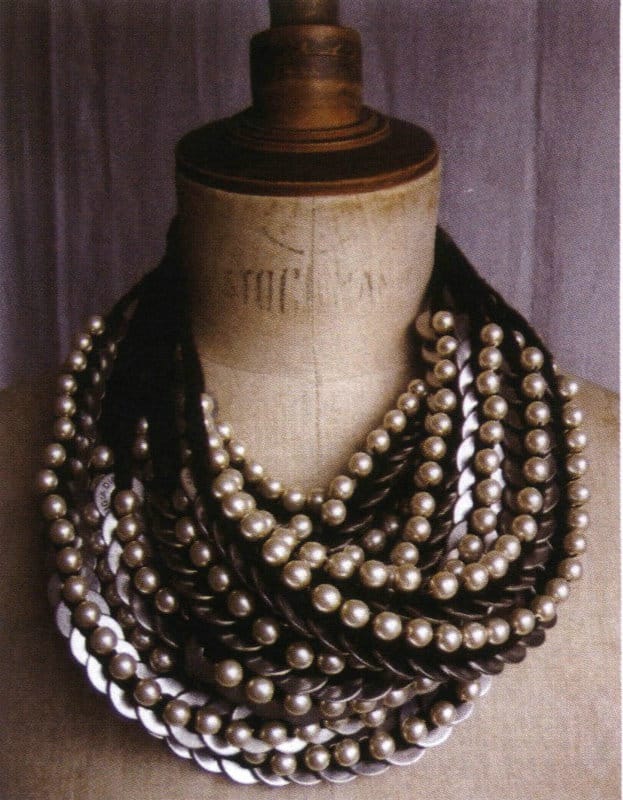
Figure 1-61 Model-assisted display

Figure 1-62 Auxiliary display tools will enhance the exhibits through various shaped bases and blocks.

Figure 1-63 Display form of jewelry boxes

Figure 1-64 Using simple solid wood to highlight the nobility of gold jewelry
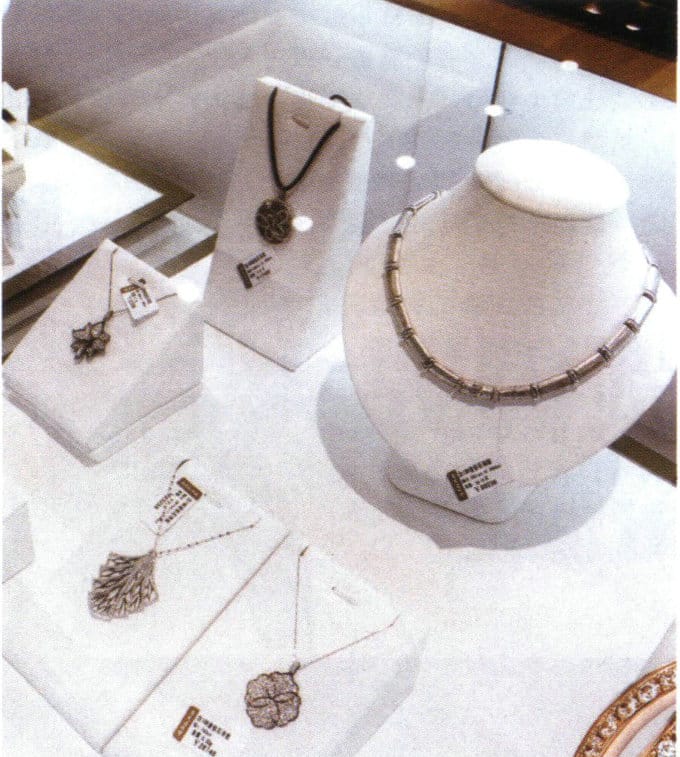
Figure 1-65 Display of different shaped building block combinations
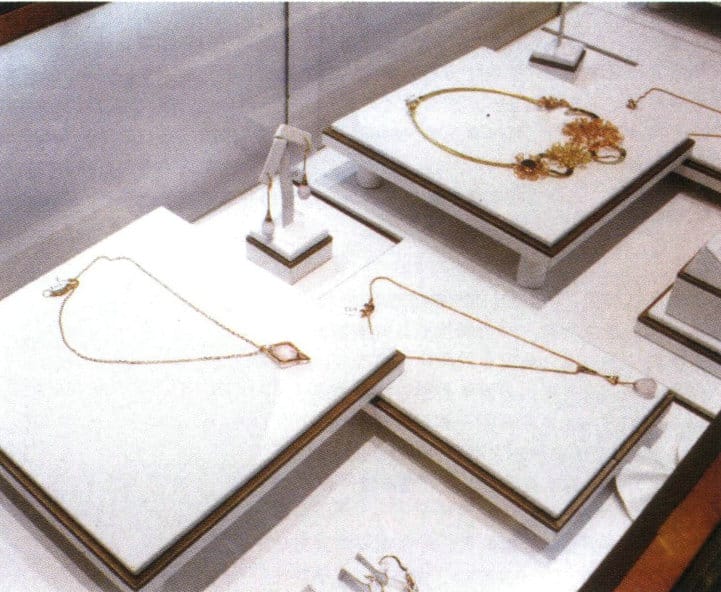
Figure 1-66 Display of varying heights
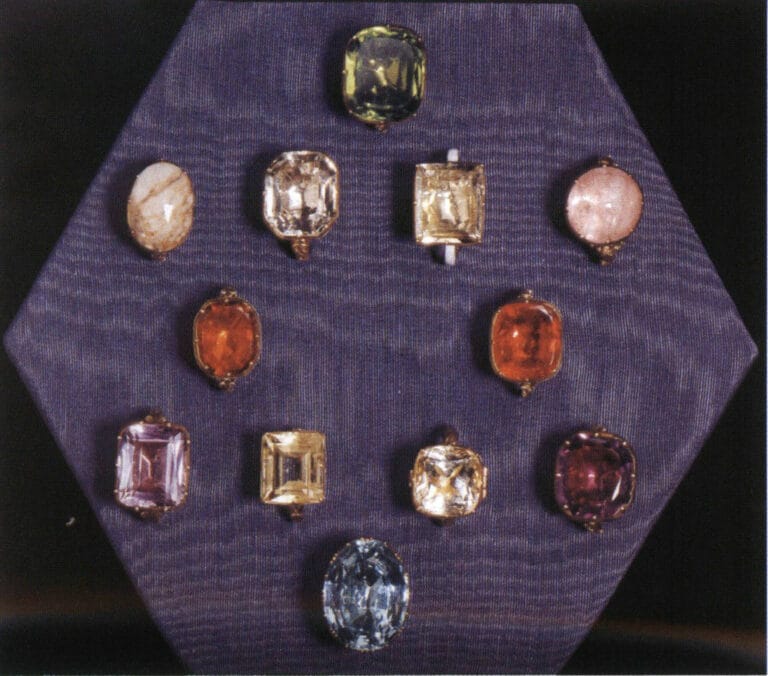
Figure 1-67 Flat Display Form

Figure 1-68 Original Wood Shaping Display
(6) Layout Design
The layout is one of the components of exhibition space design. Through the layout, the audience can clearly understand the theme and detailed content of the exhibition. Layout design mainly includes images, text, exhibits, charts, and other content. The design of the display layout differs from that of graphic design; it involves not only the variation of points, lines, surfaces, and volumes in layout form but also encompasses materials, colors, lighting, and other expressive techniques.
The overall plan generally includes a layout design, including the position of the title, text, background, and color tone of the layout, as well as the form of images (Figure 1-69 to Figure 1-72).

Figure 1-69 Celebrity Effect Display
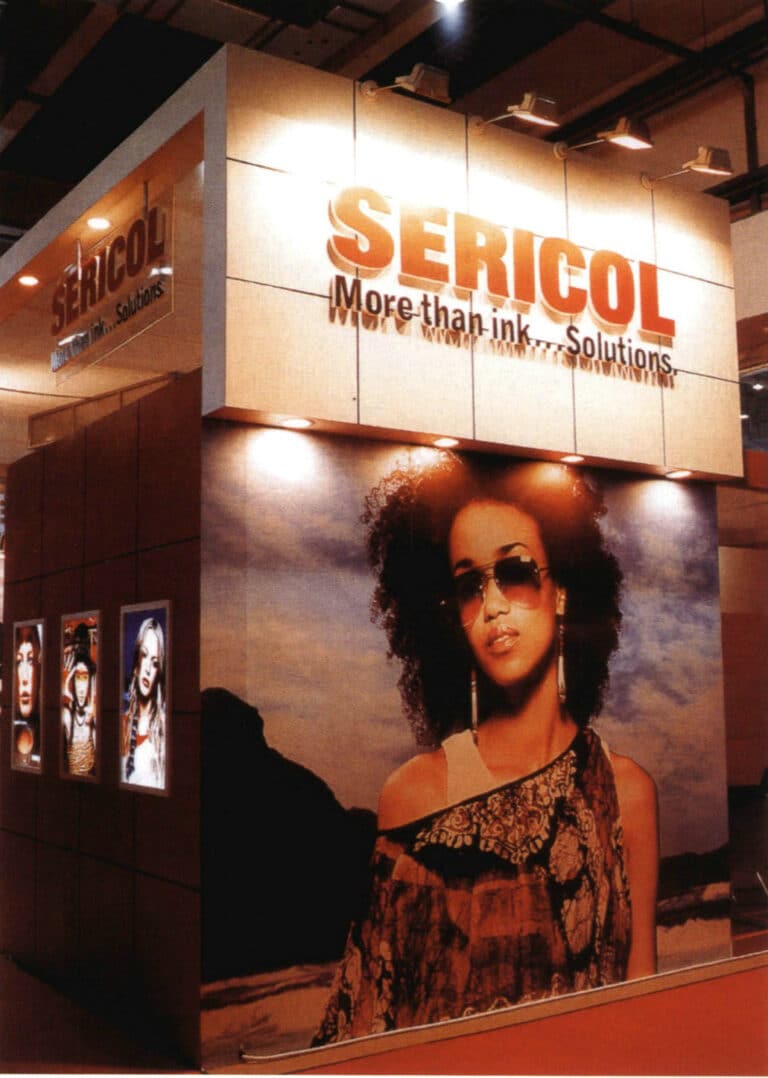
Figure 1-70 Large Commercial Theme Poster
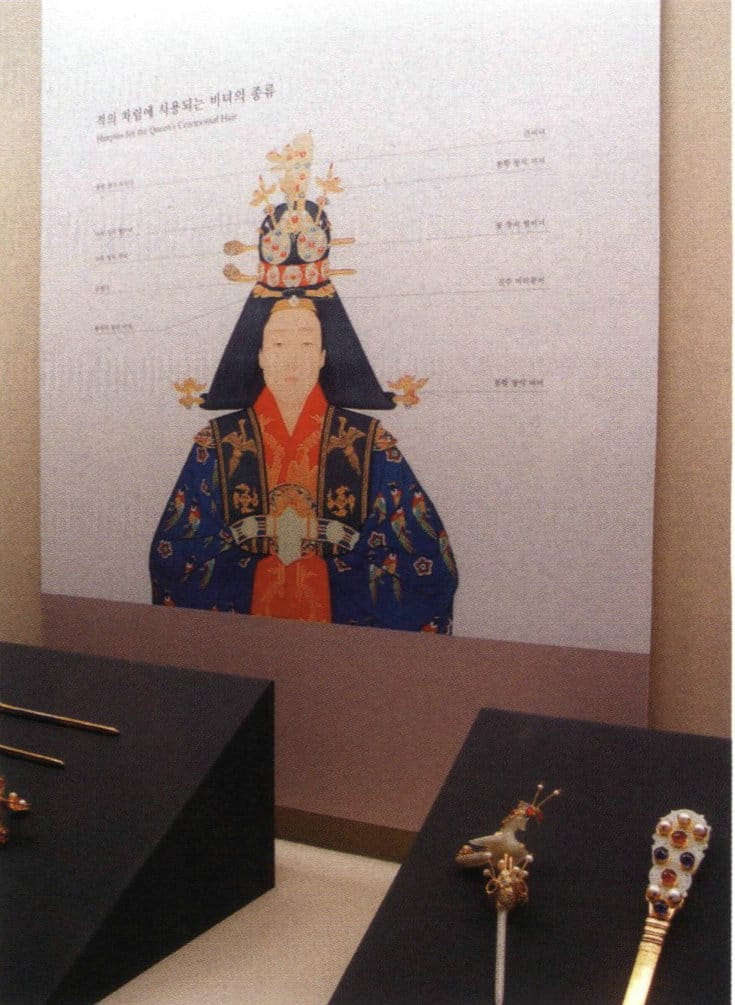
Figure 1-71 Combination display of real objects and illustrations
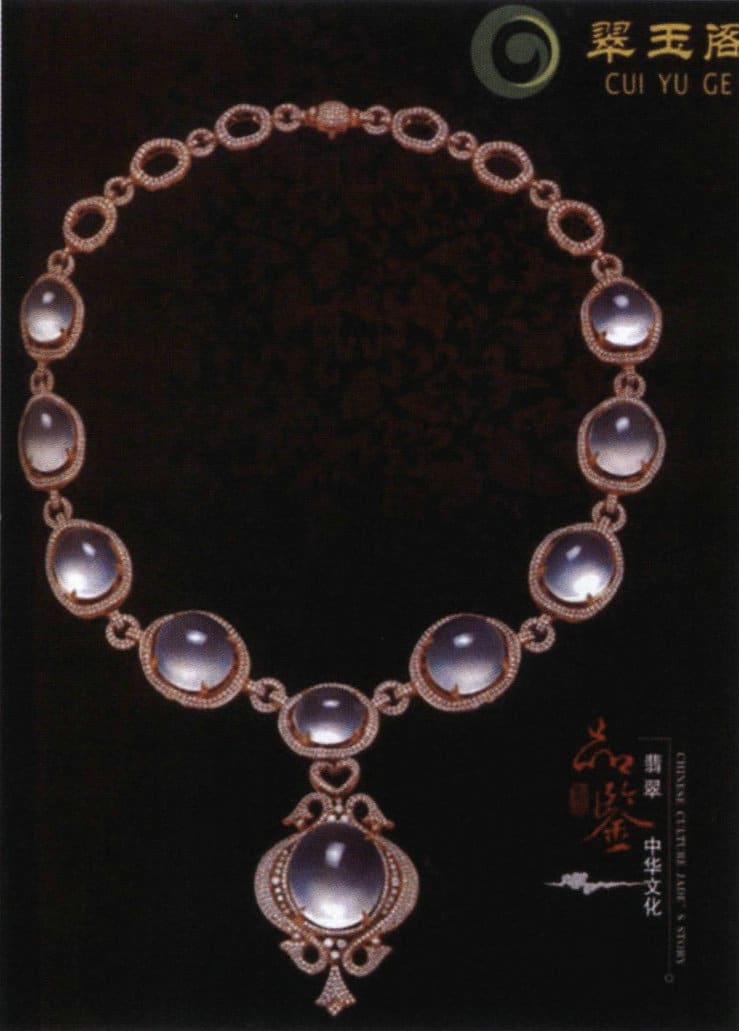
Figure 1-72 Jewelry-themed poster
2. Jewelry Display Lighting Design and Application
Lighting Design
Enhancing the environmental atmosphere is an extremely important characteristic of light. In exhibition spaces, lighting design can transform simple shapes into rich ones. The main role of light in shaping space is reflected in: light can express the characteristics of the shapes of spatial components, alter the visual texture of certain materials to varying degrees, and create subtle changes in sensations such as warmth and coolness, heaviness and lightness, softness, and hardness.
Good exhibition lighting design can create an atmosphere, establish visual guidance, generate a sense of movement, enhance three-dimensionality, expand space, enrich the layers of display props, adjust the color structure of the exhibition space, and highlight the role of key displayed items. This allows visitors to clearly and comfortably see the exhibits and enhances the aesthetic appeal of the items, bringing a pleasant viewing experience to the audience.
The types of display lighting can be divided into basic, local, and ambient lighting.
1) Basic lighting (Figure 1-73)
2) Local lighting (Figures 1-74, 1-75)
3) Ambient lighting (Figure 1-76, Figure 1-77)
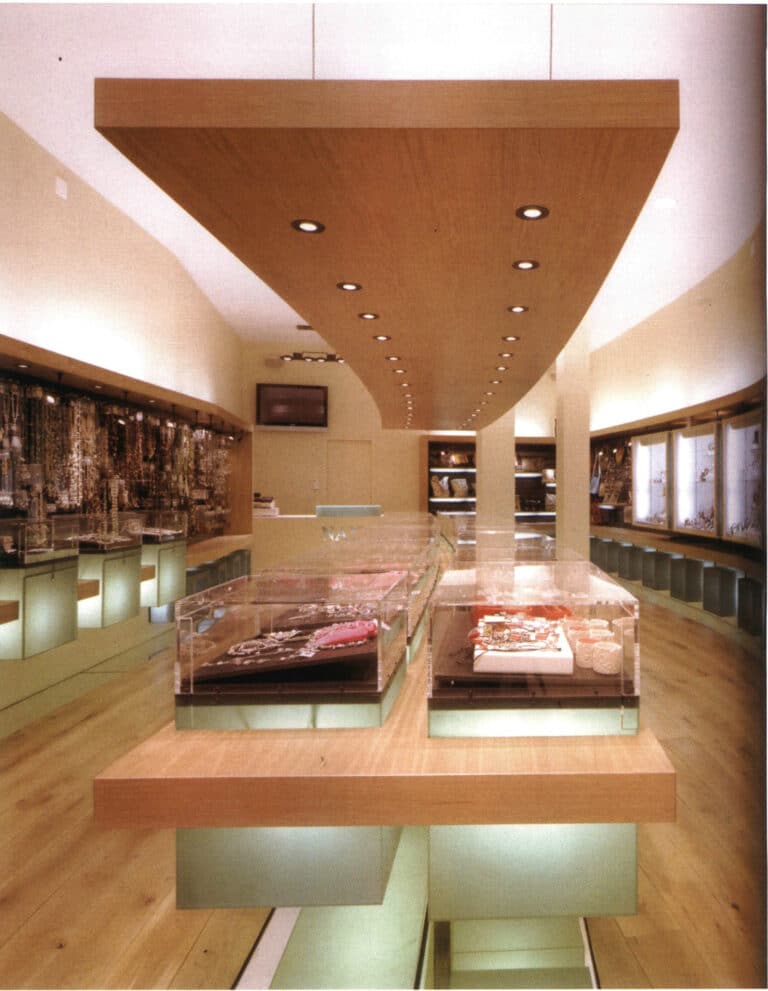
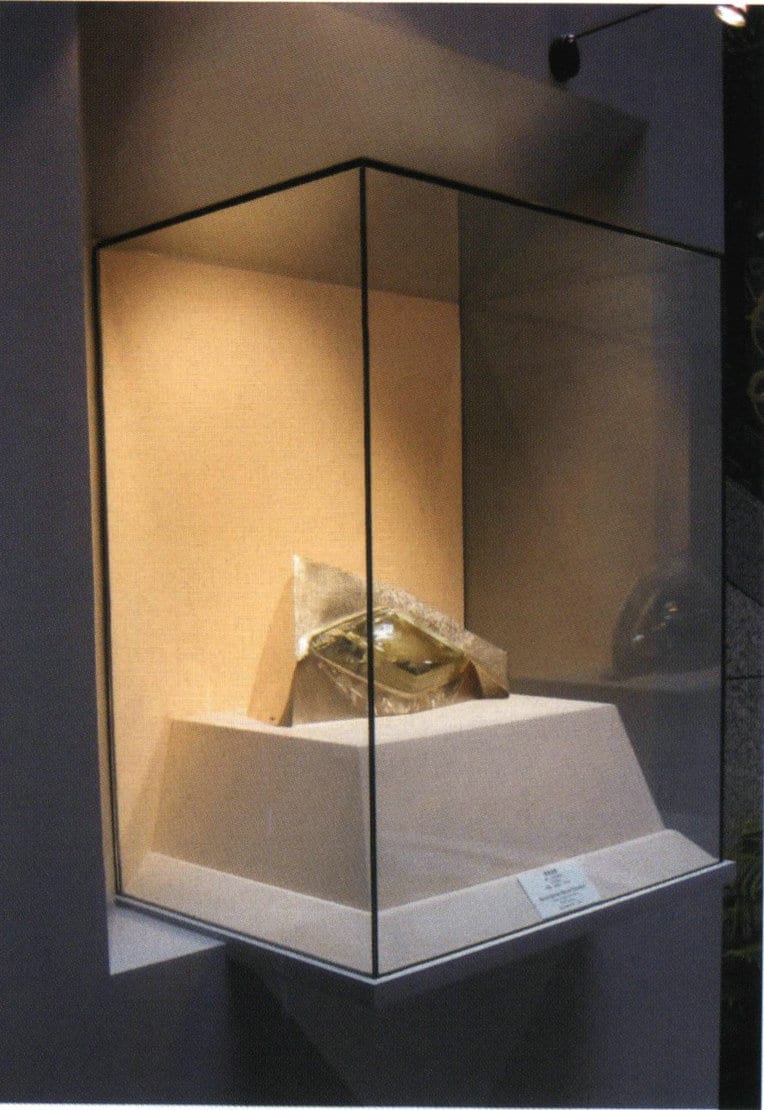
Figure 1-74 Partial lighting in a glass display cabinet

Figure 1-75 Highlighting exhibits with point light sources
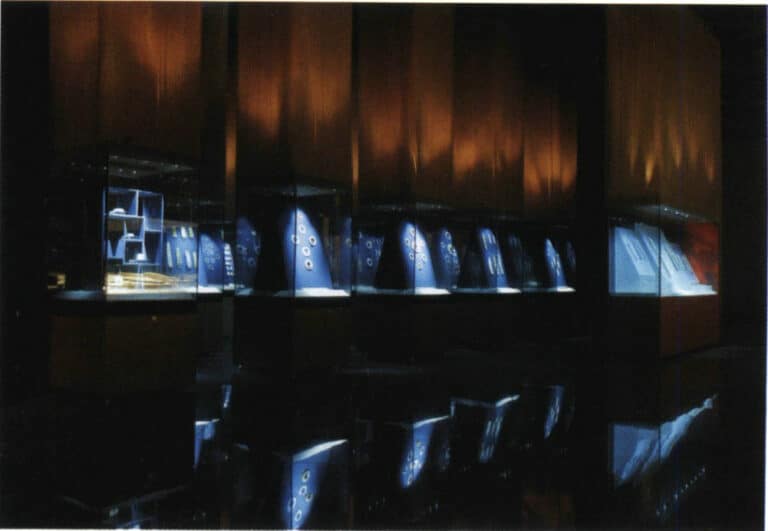
Figure 1-76 Creating a display atmosphere with colored light sources
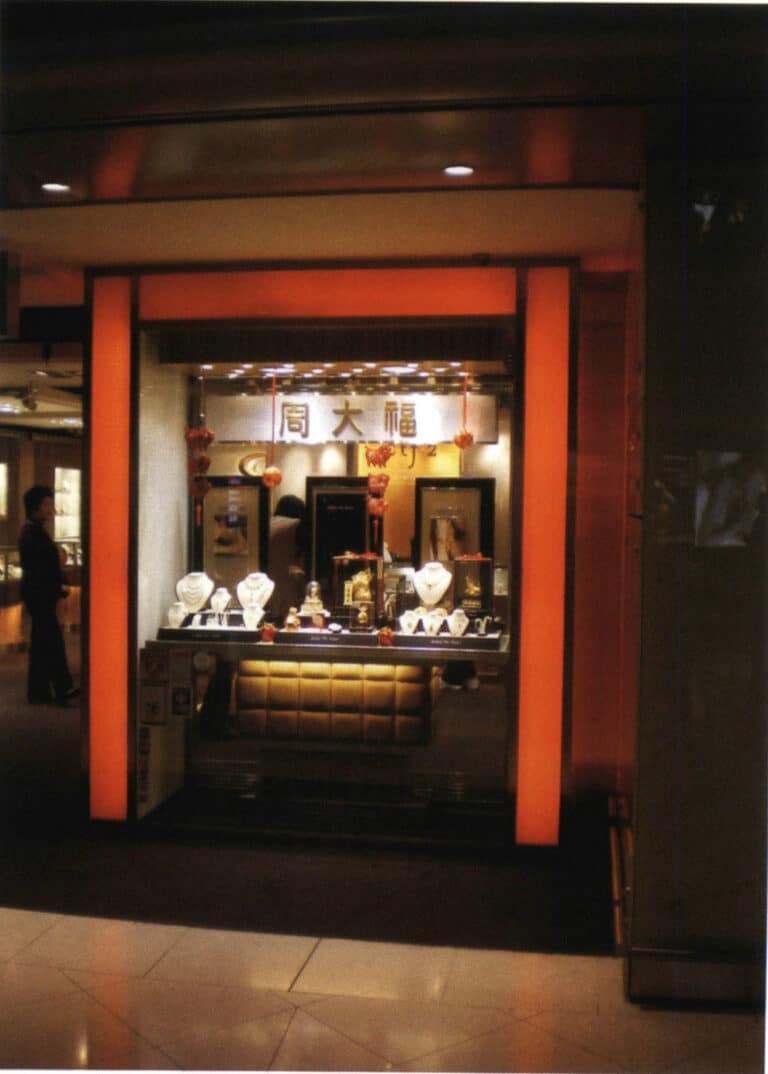
Figure 1-77 Creating a festive atmosphere with warm tones
3. Color Design and Application for Jewelry Display
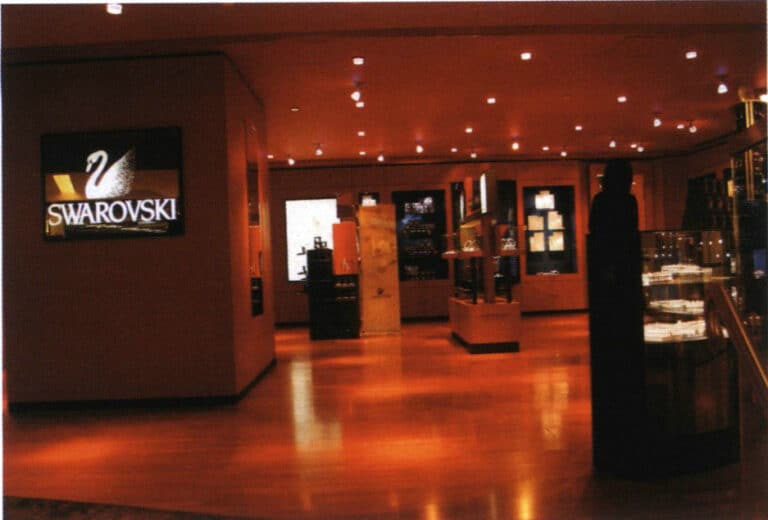
Figure 1-78 Brand jewelry has its unified color tone for display
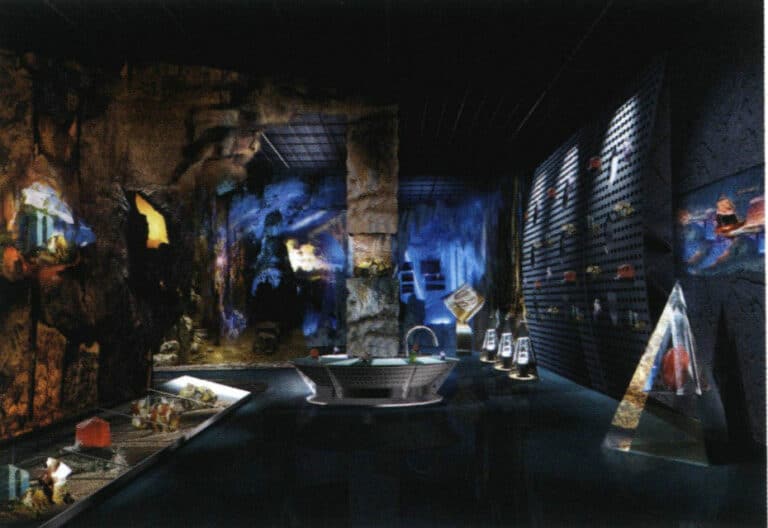
Figure 1-79 Blue lighting creates an atmosphere
4. Multimedia Design and Application of Jewelry Display
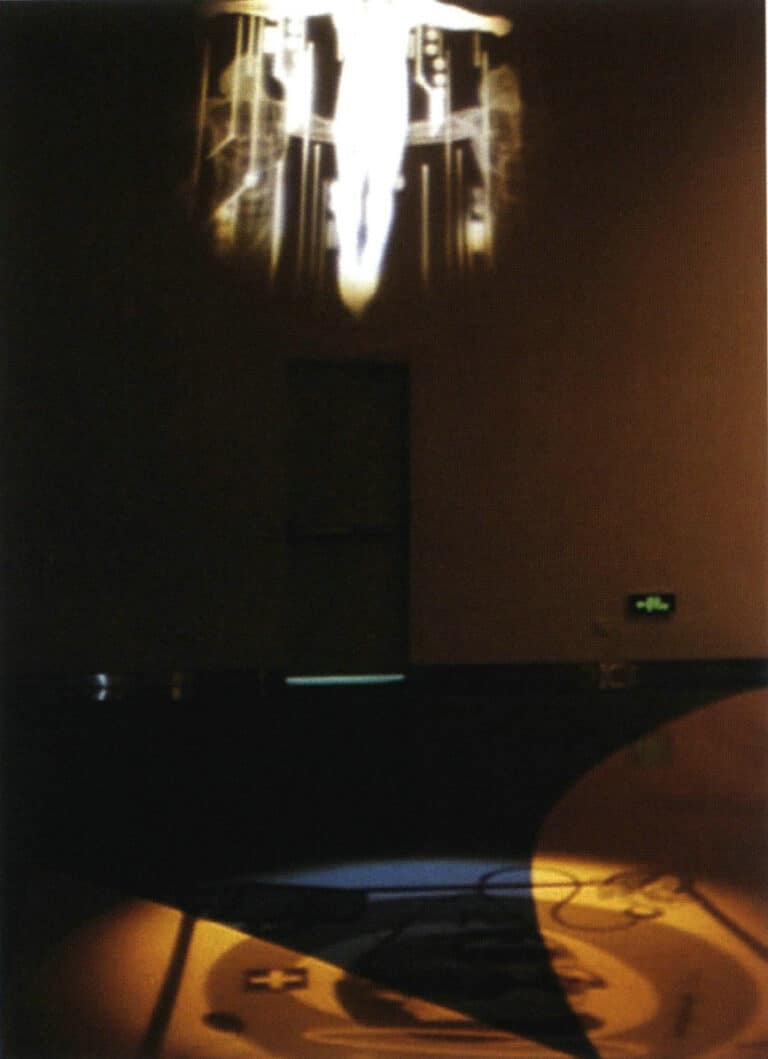
Figure 1-80 Adding technological display methods at the exhibition site

Figure 1-81 The use of technological means creates an aura of mystery around the jewelry
Copywrite @ Sobling.Jewelry - Produsen perhiasan khusus, pabrik perhiasan OEM dan ODM







